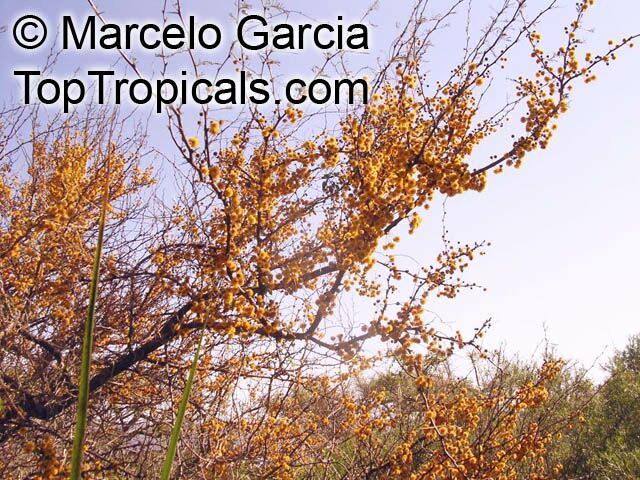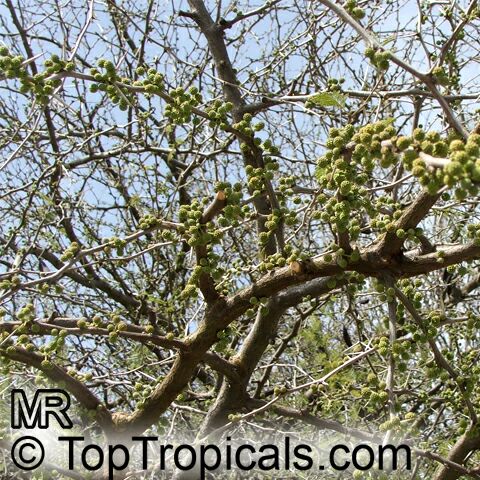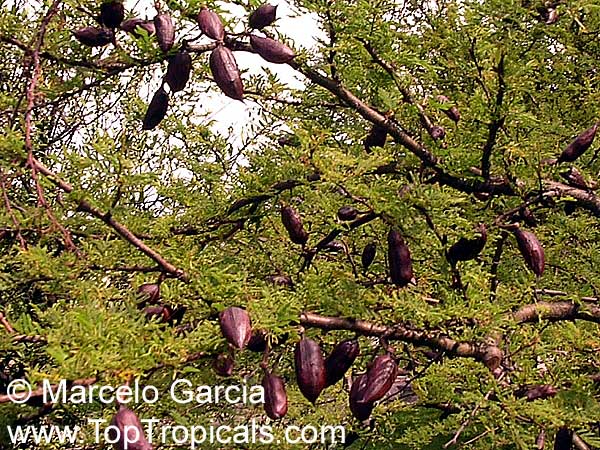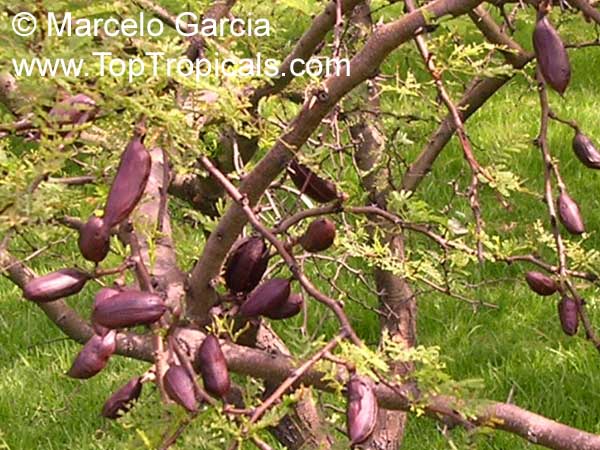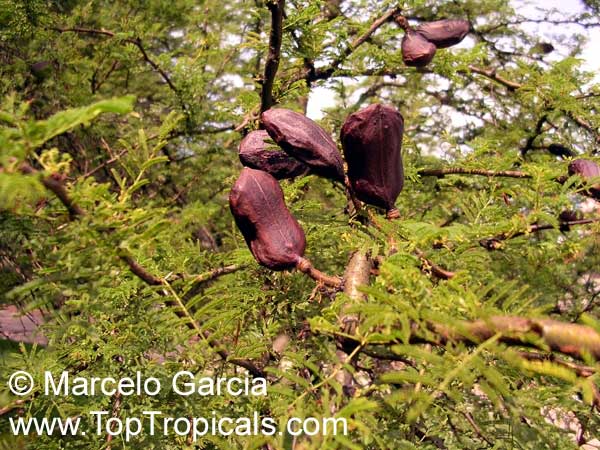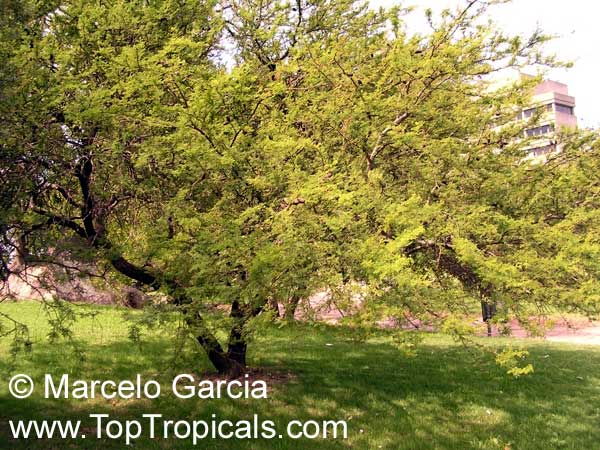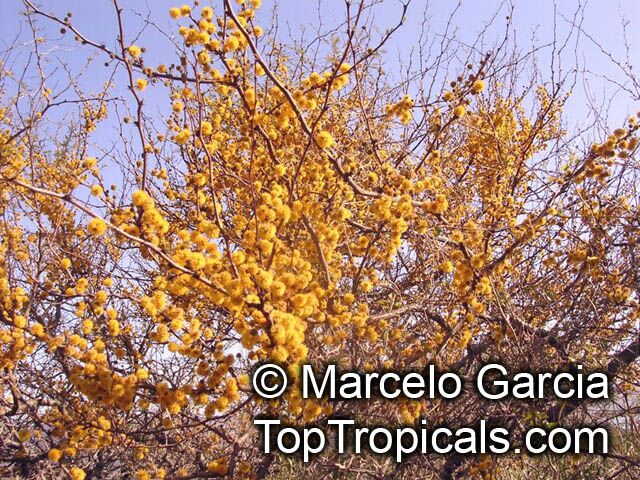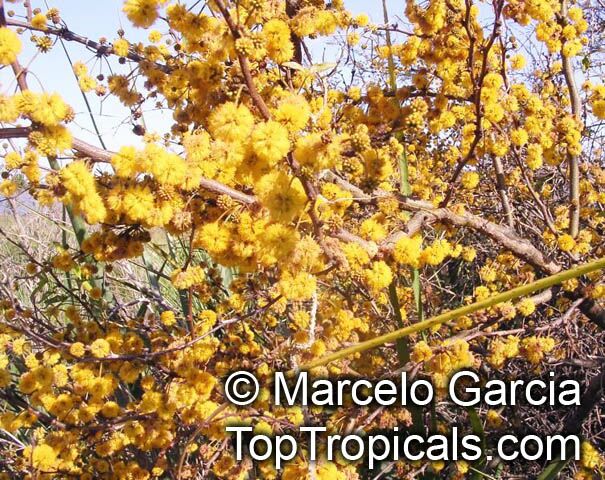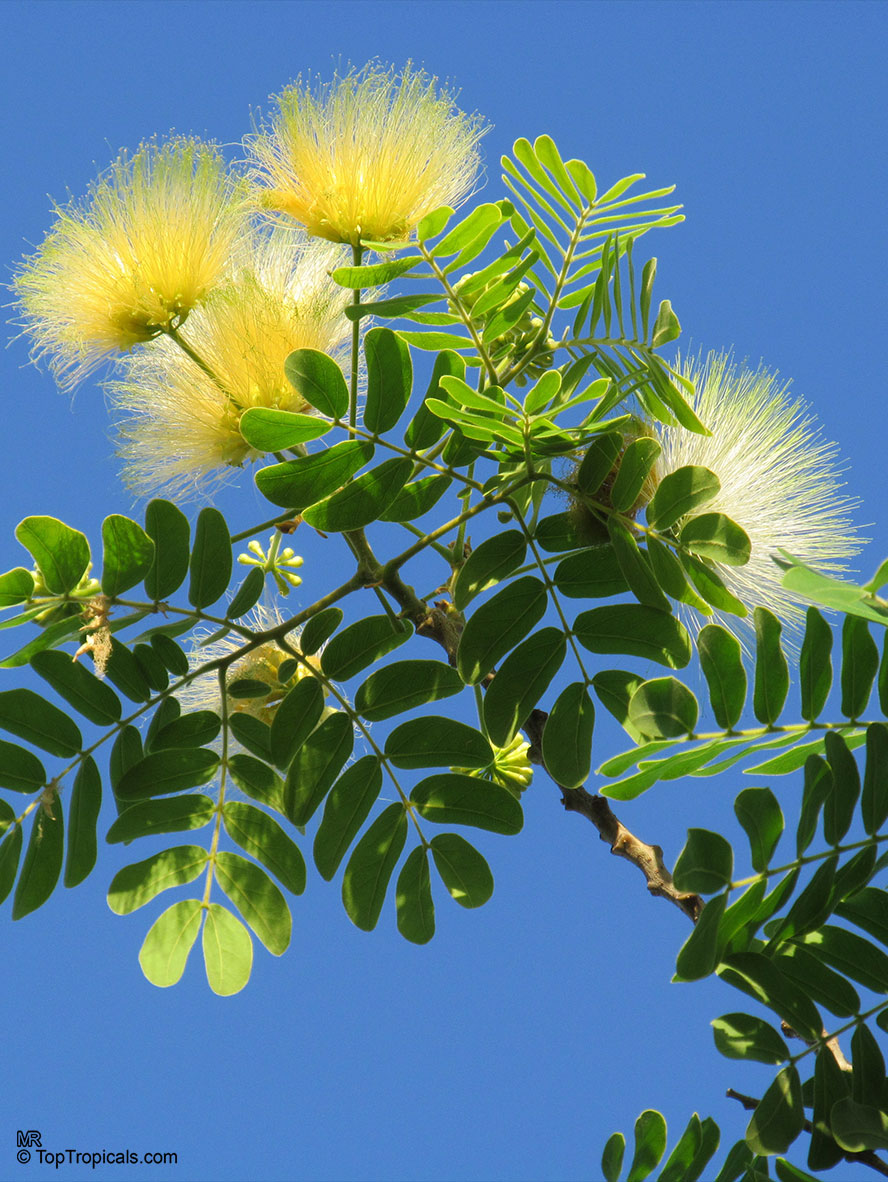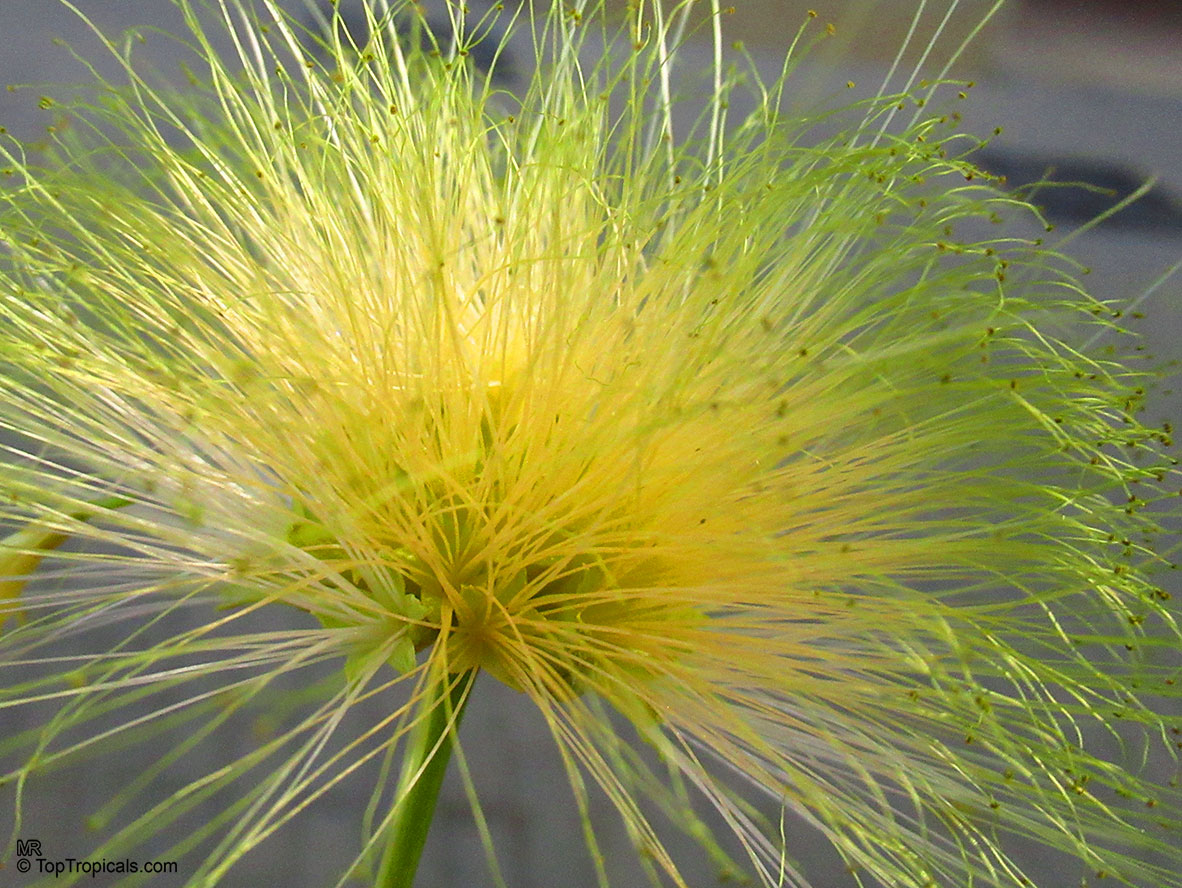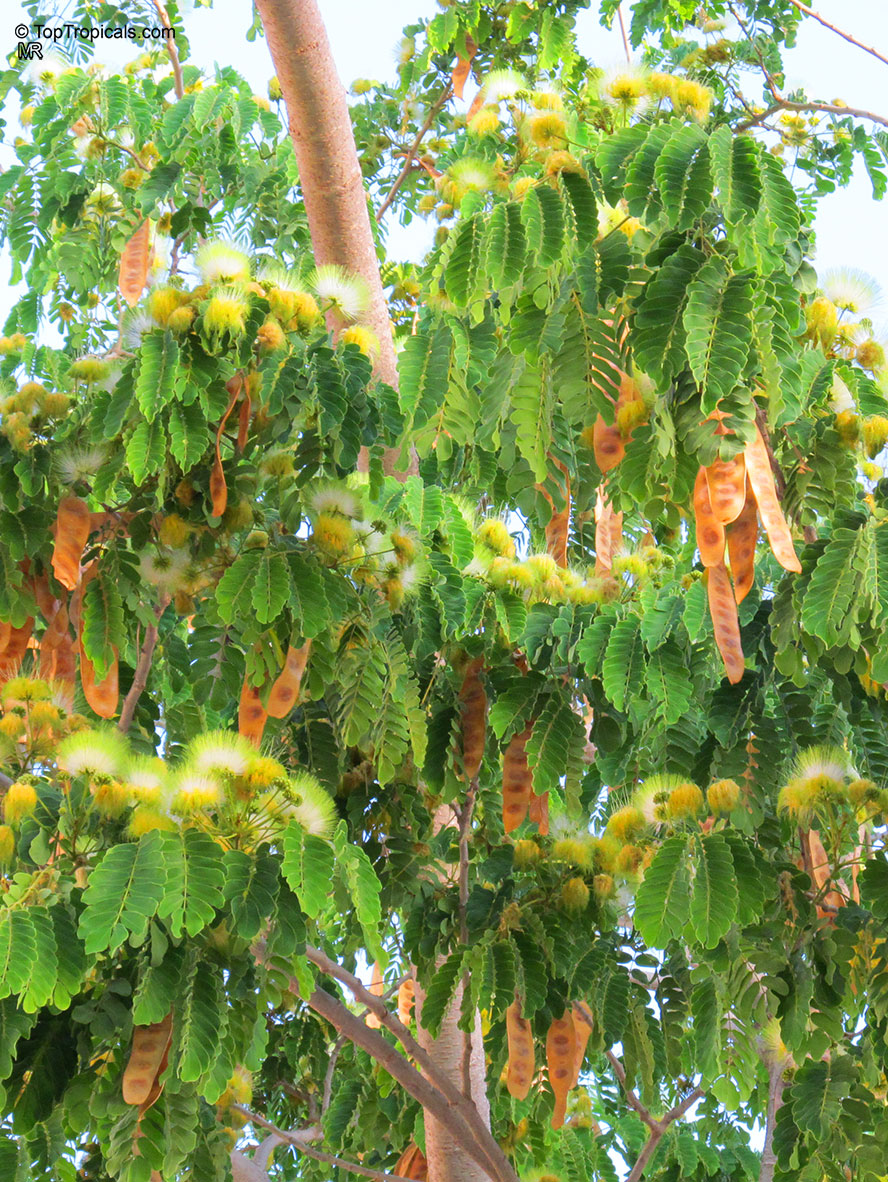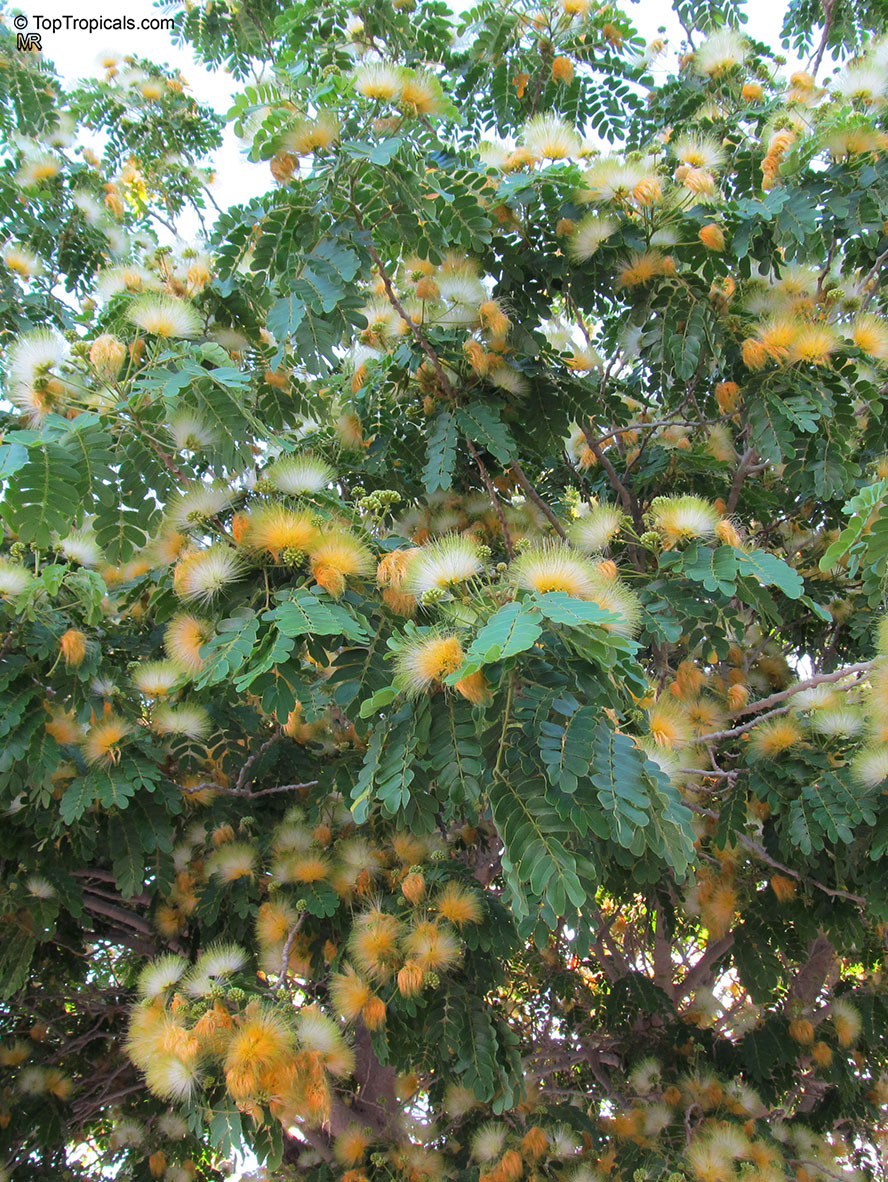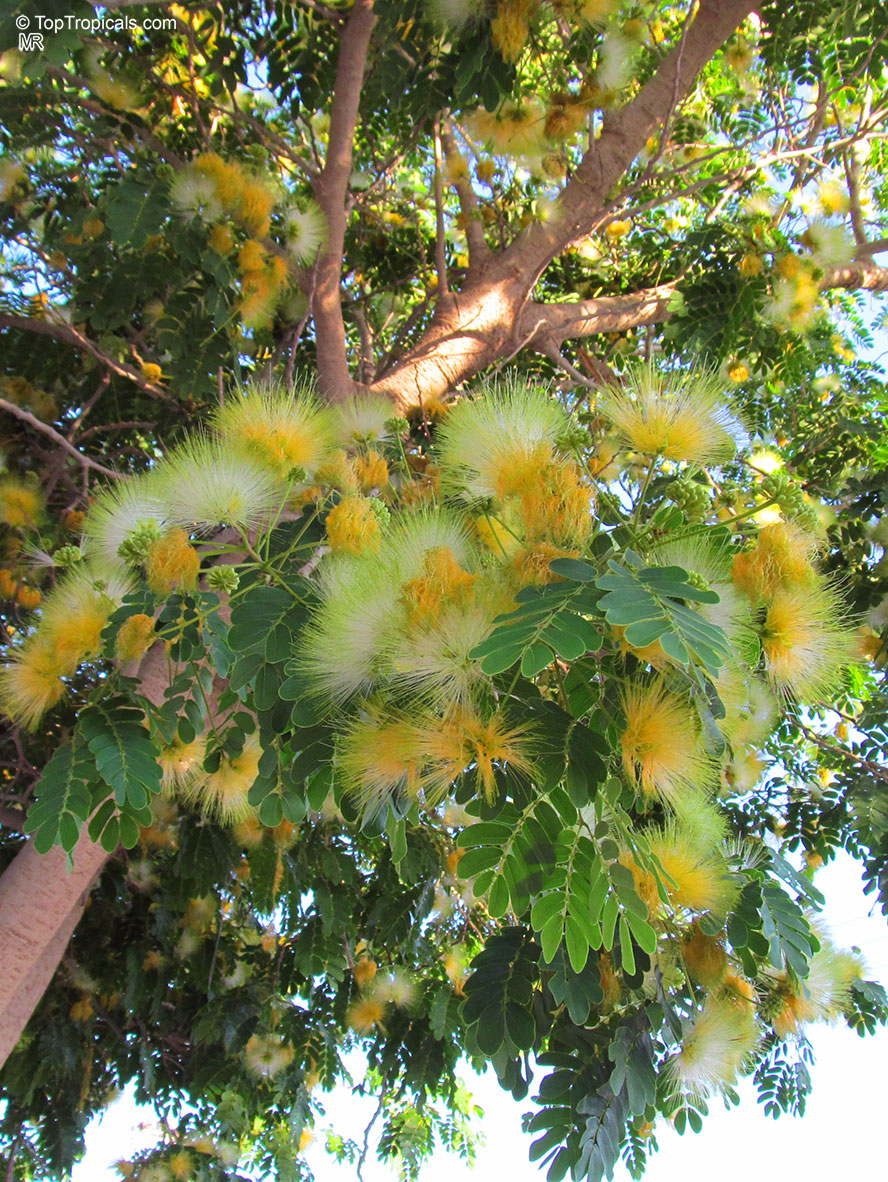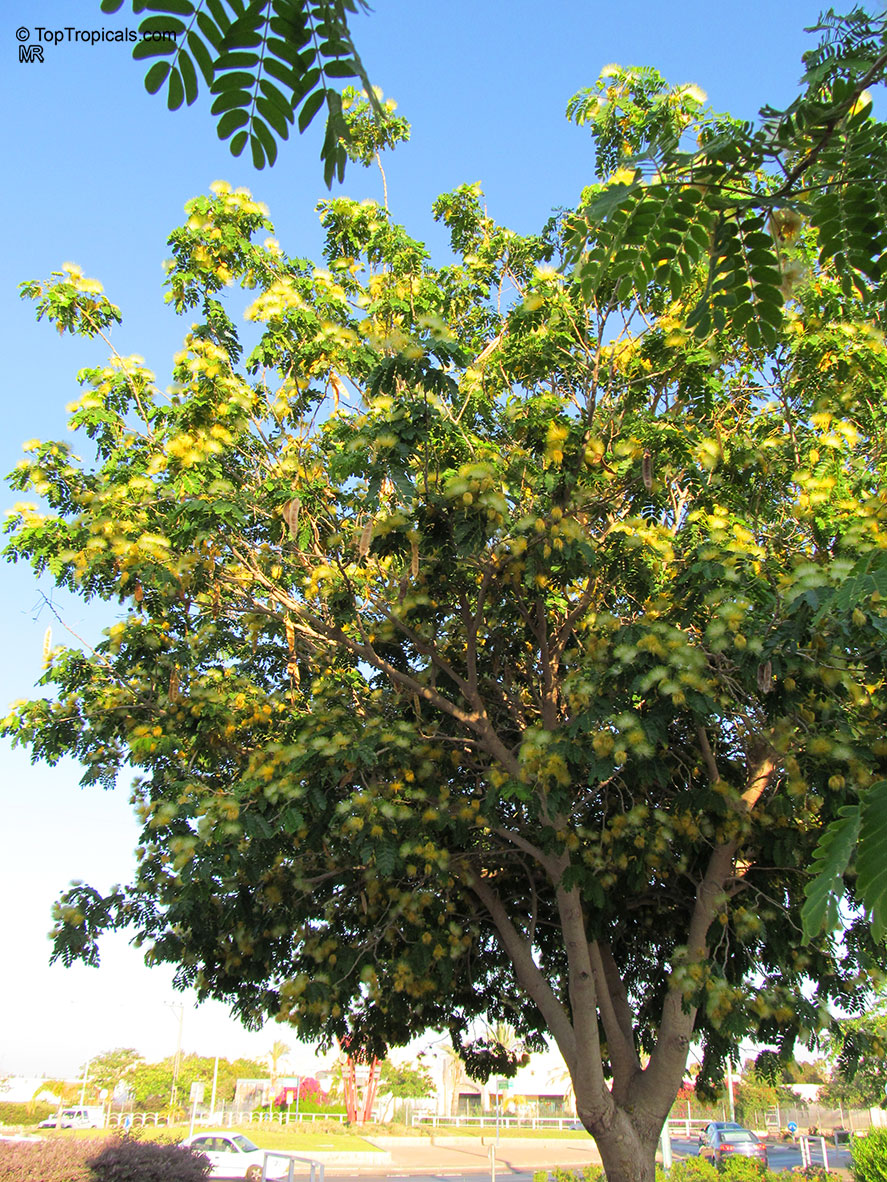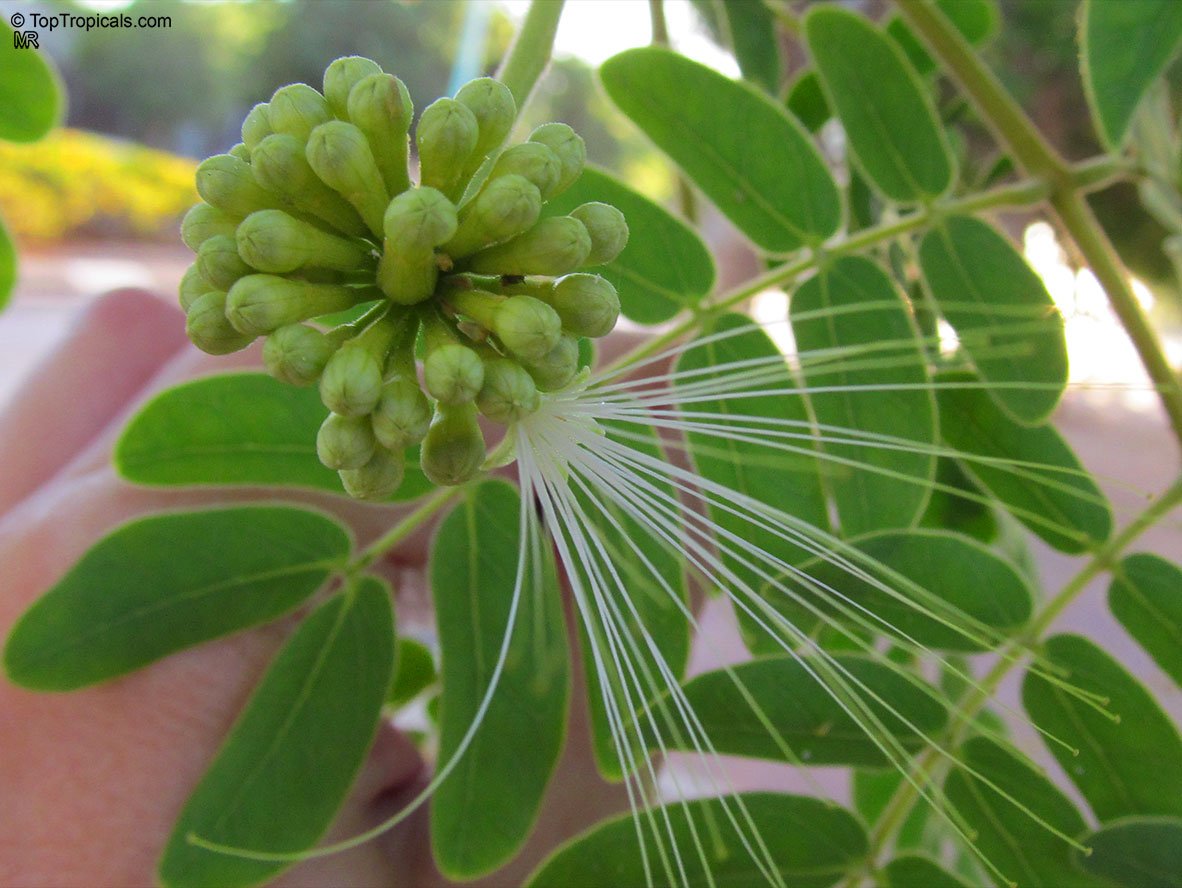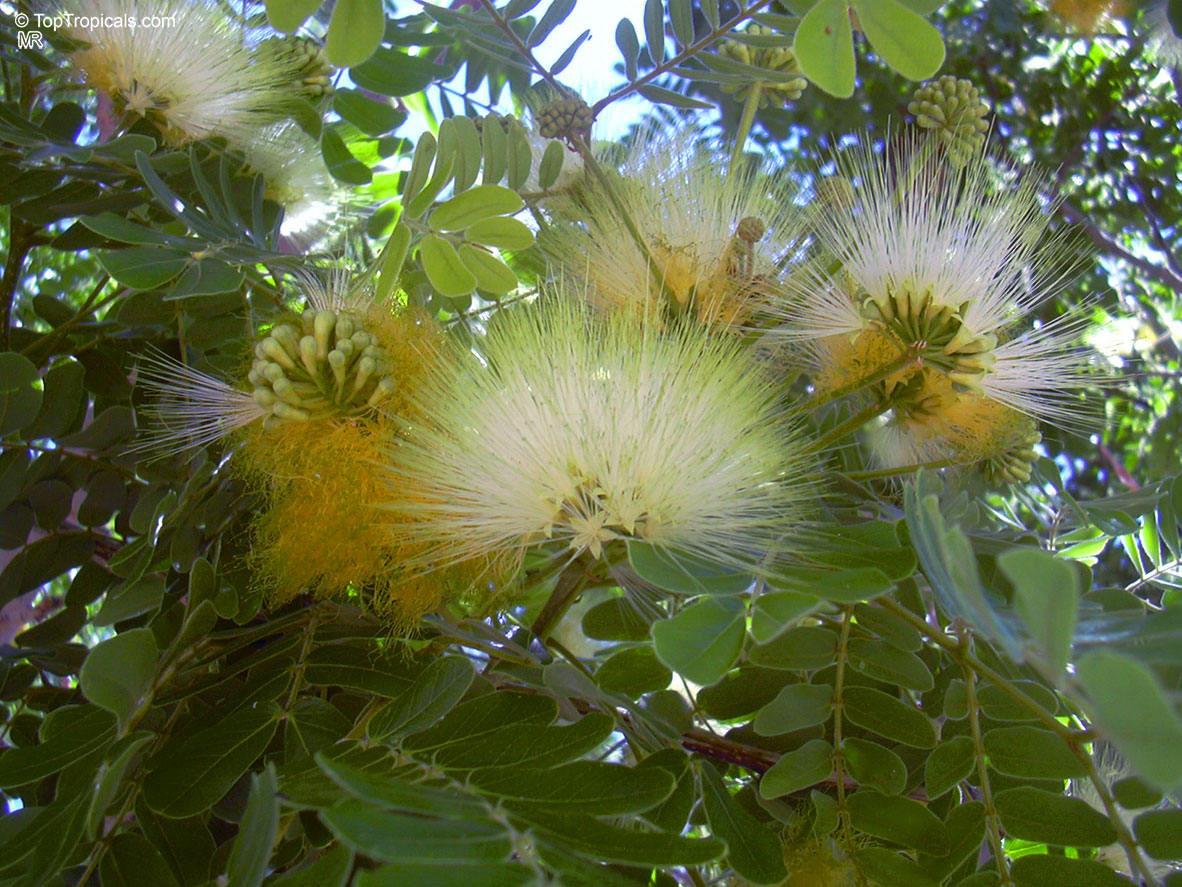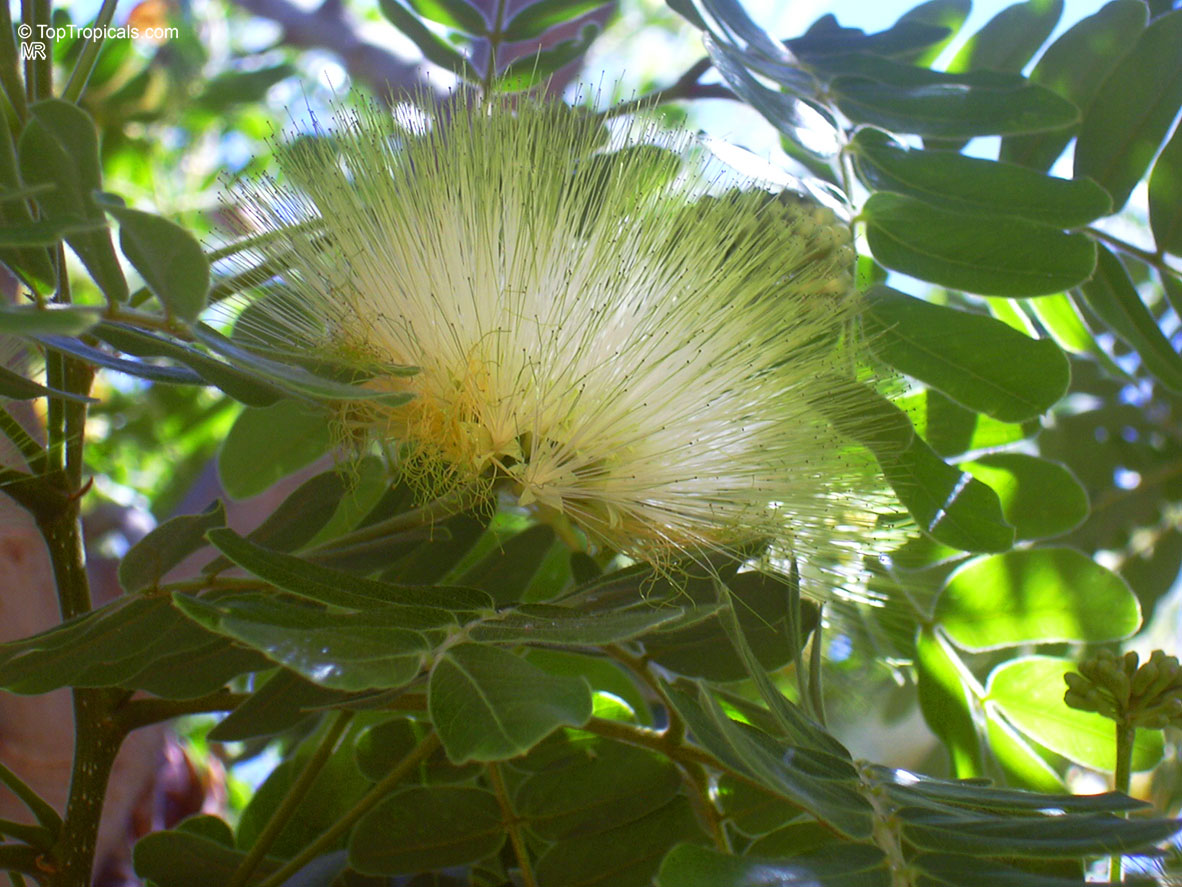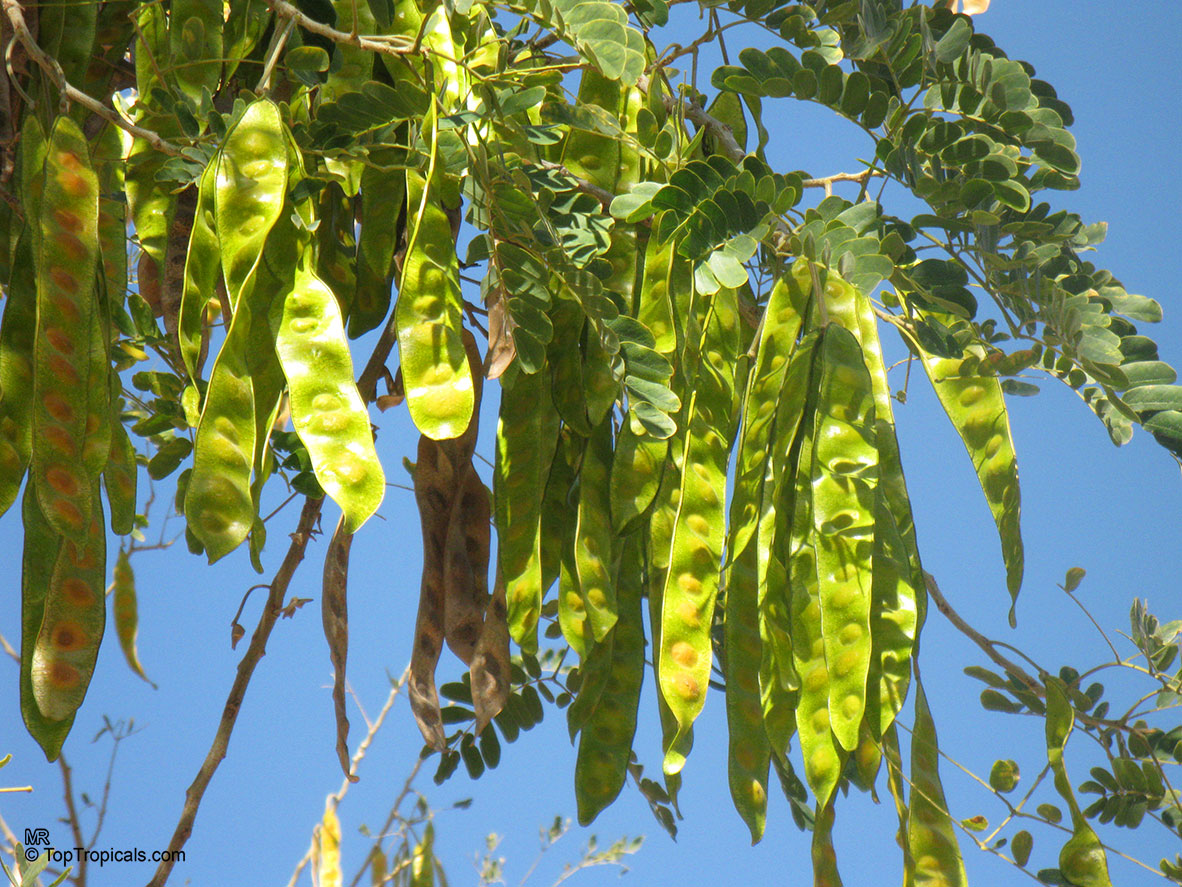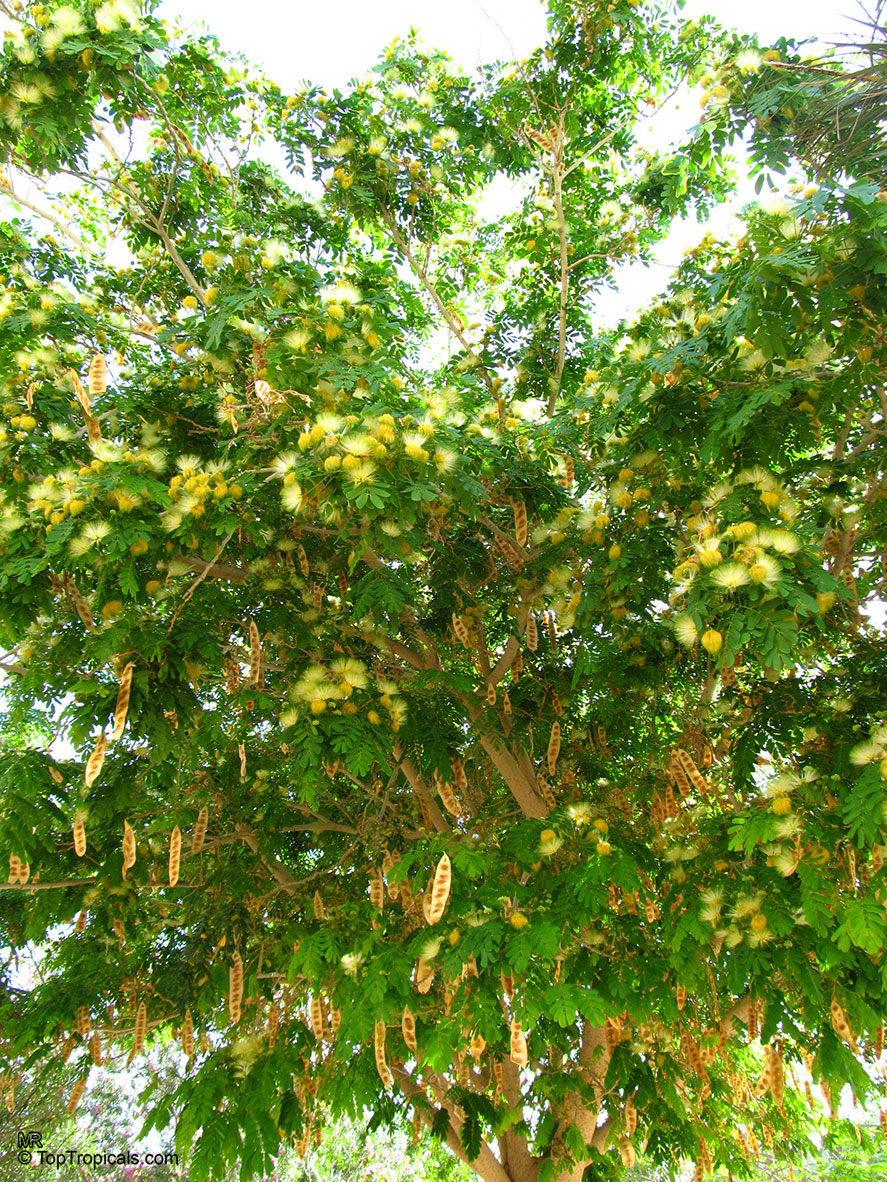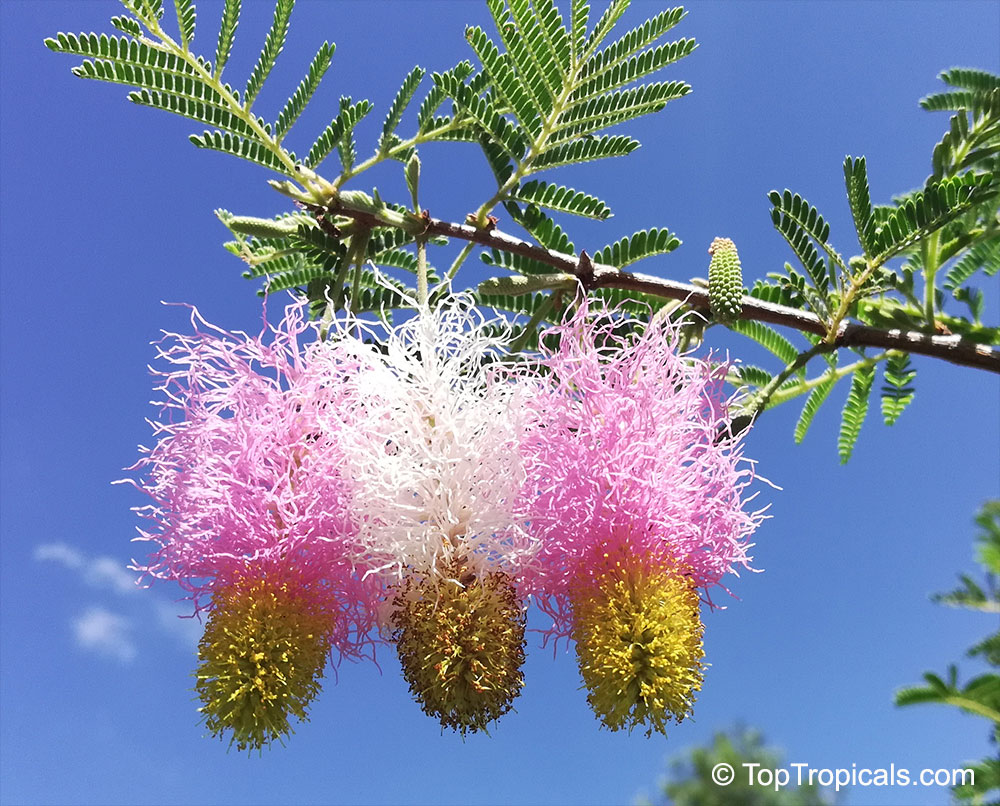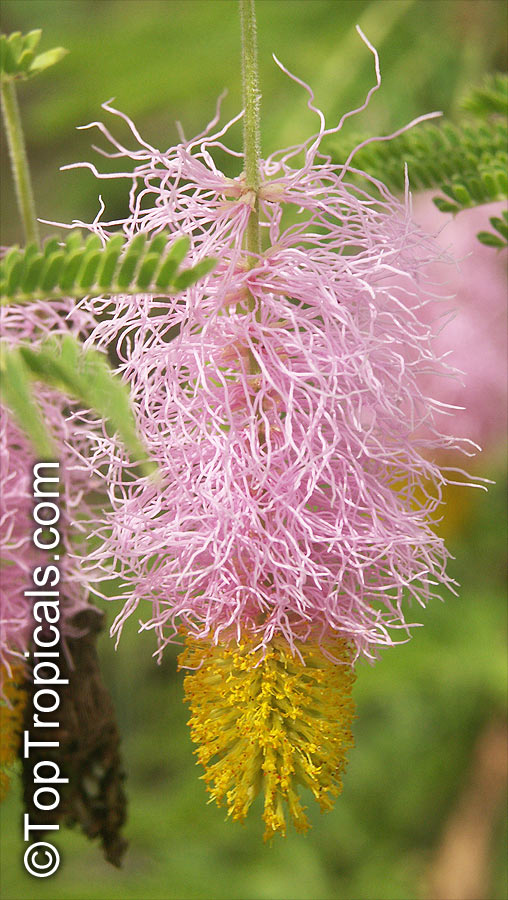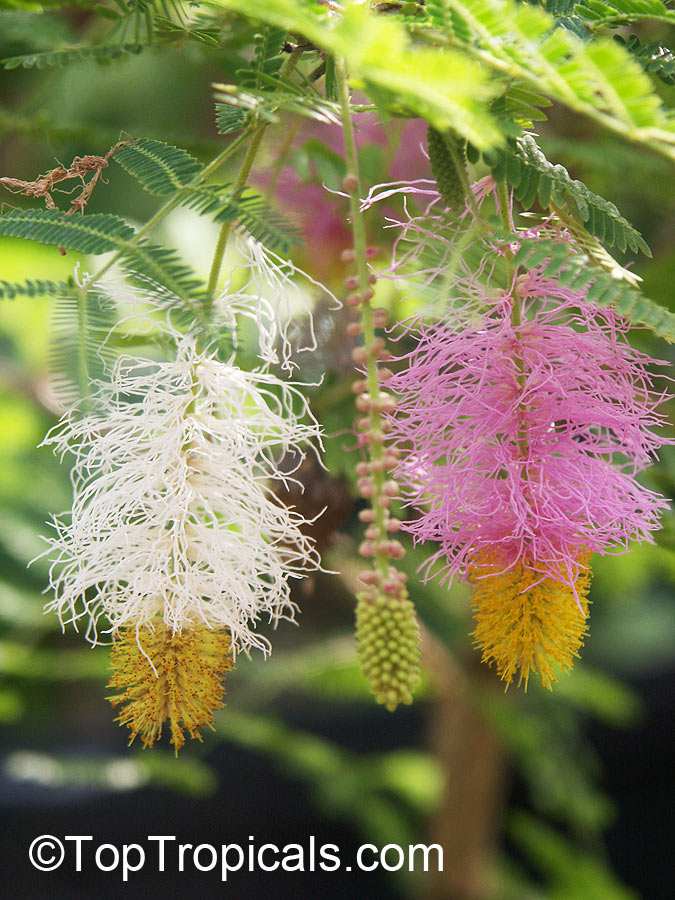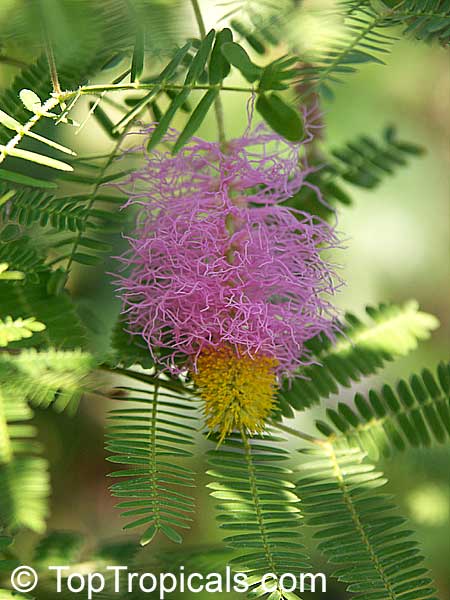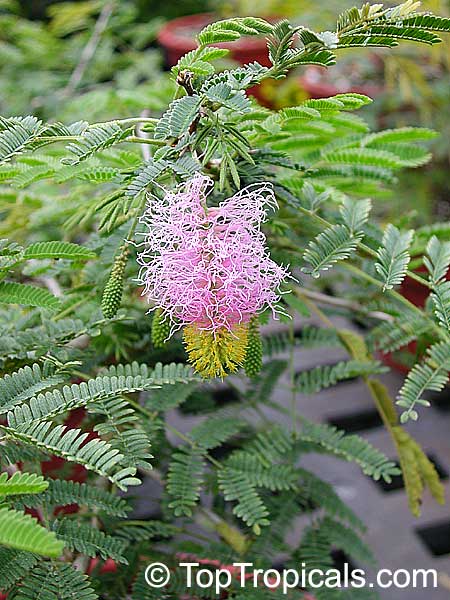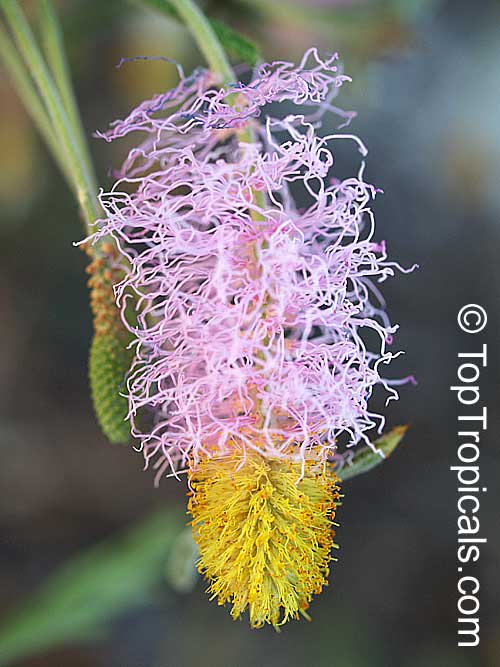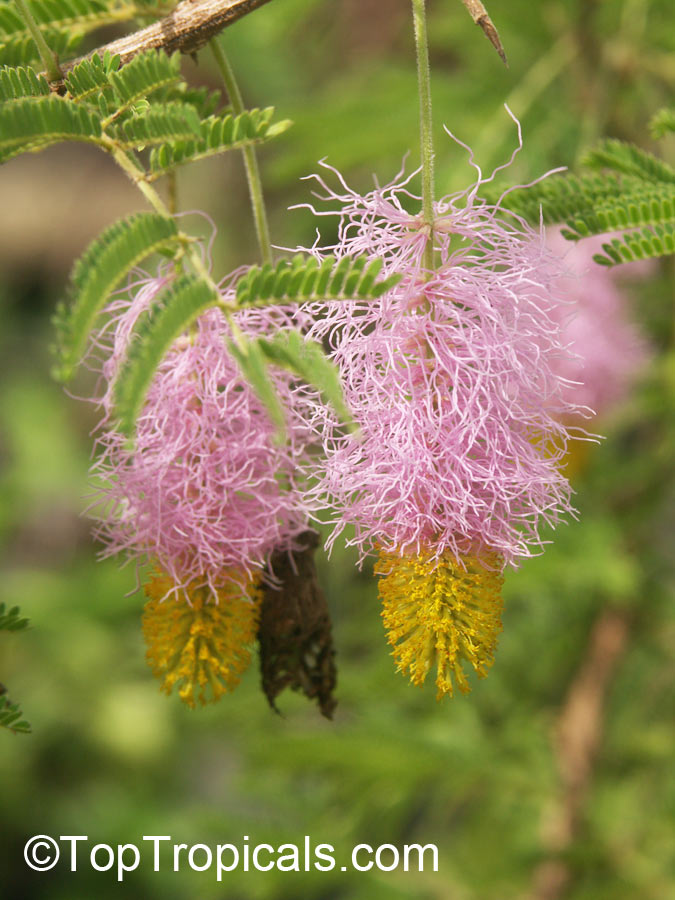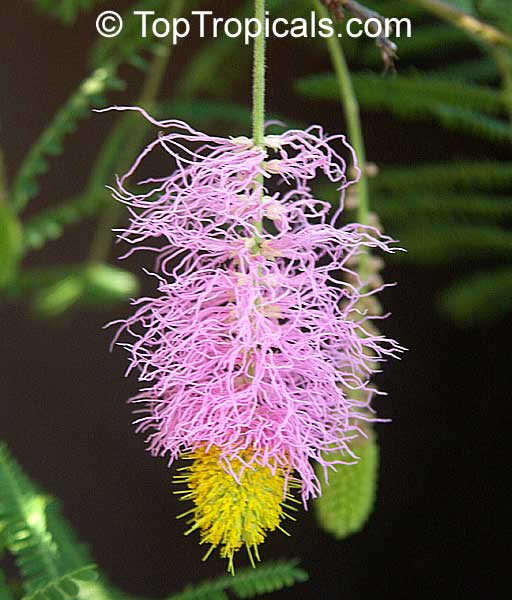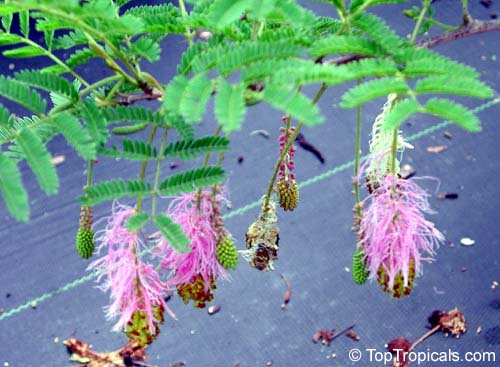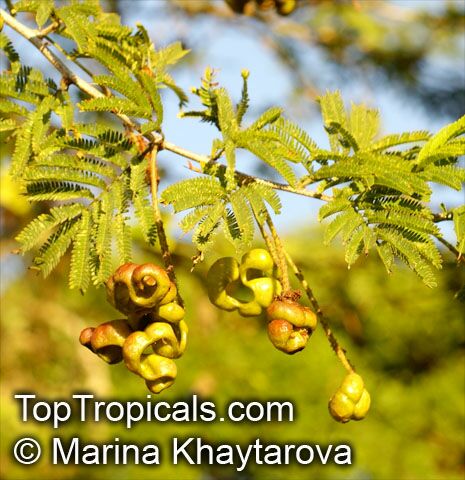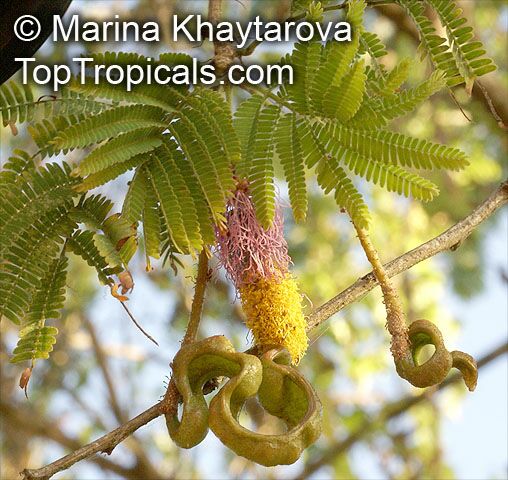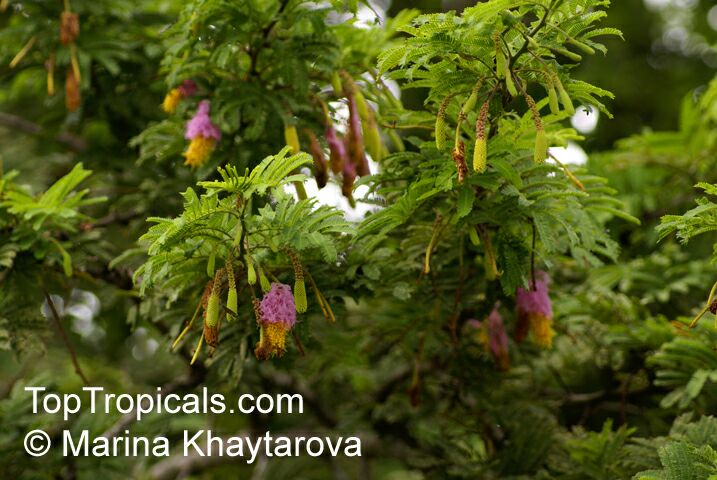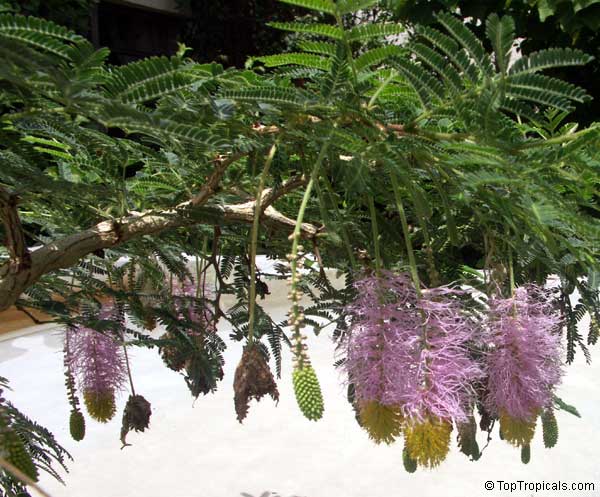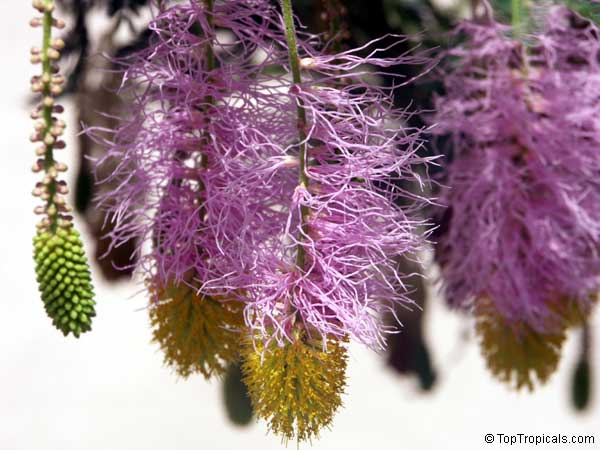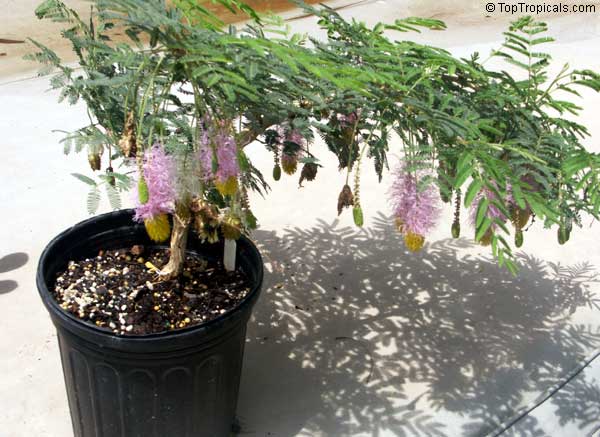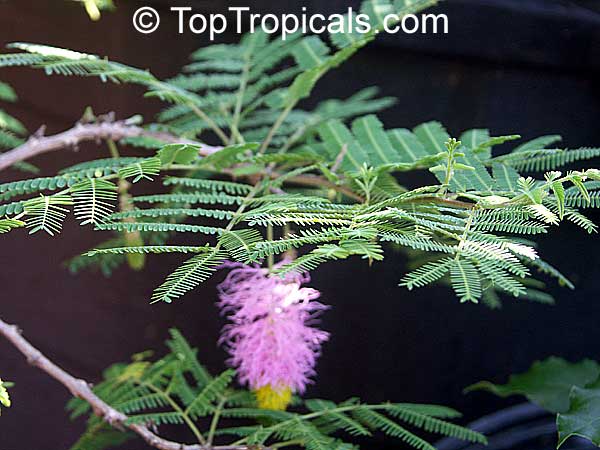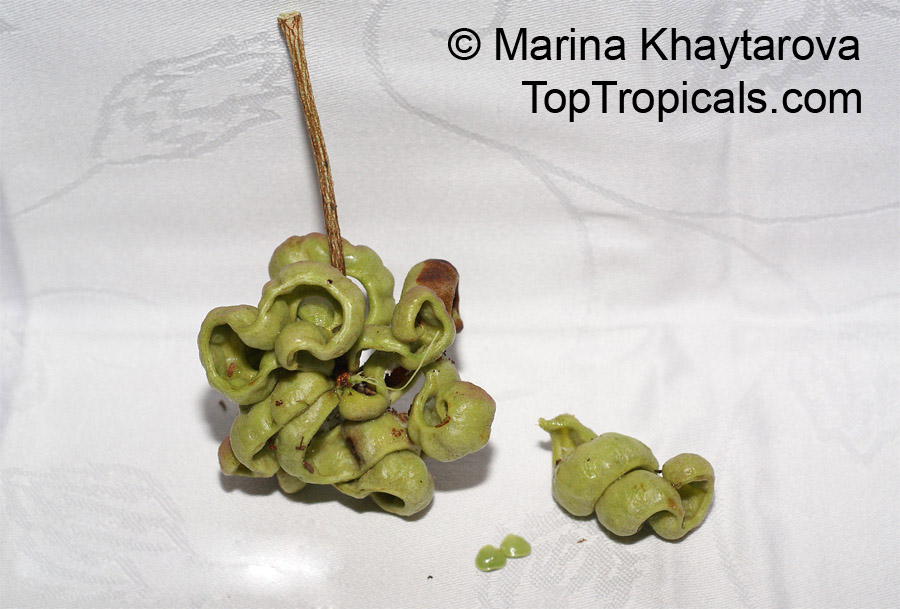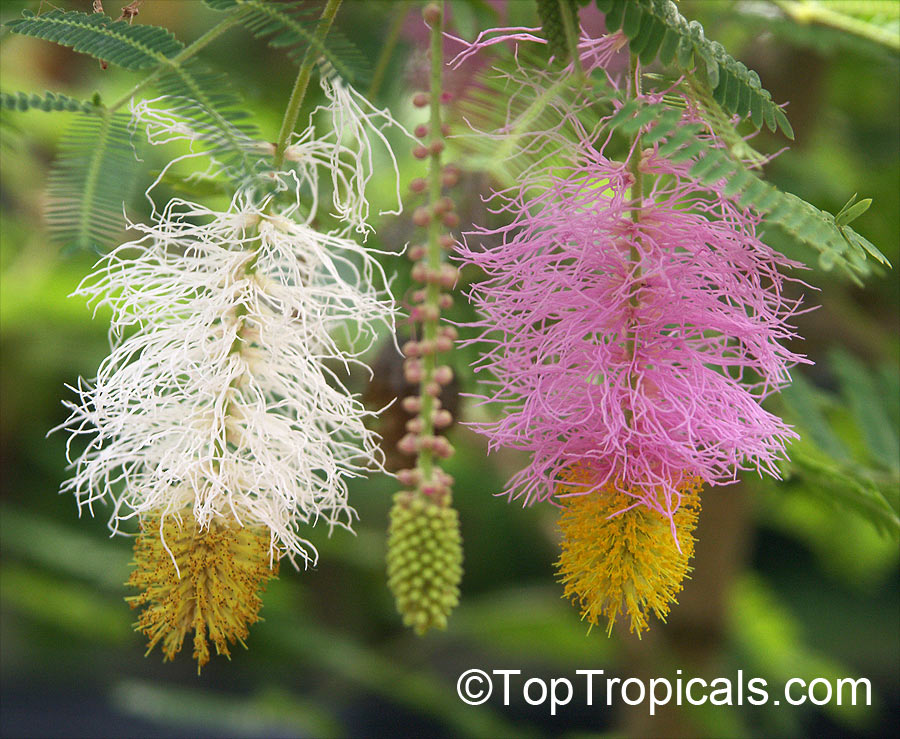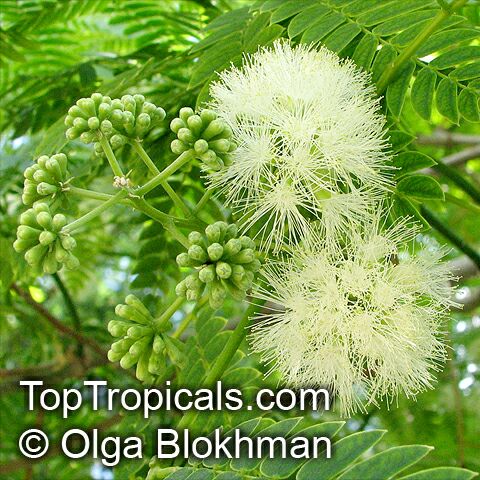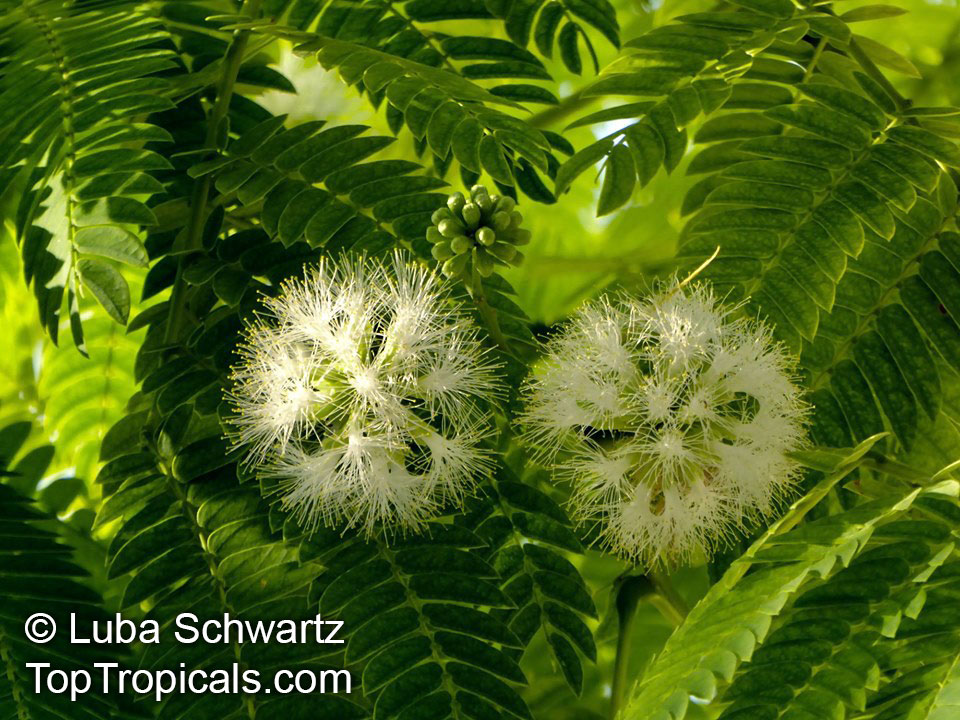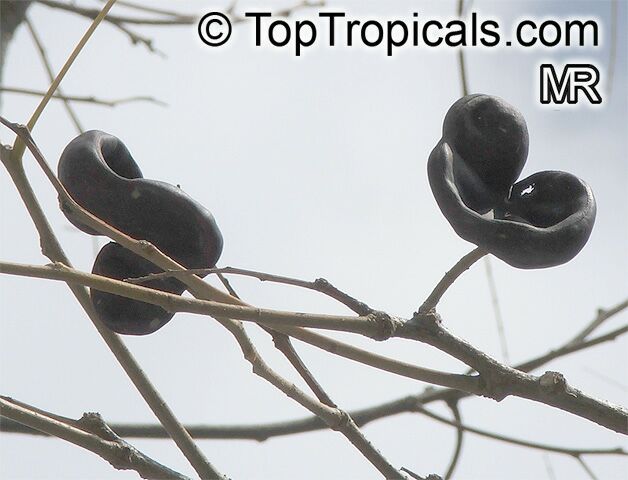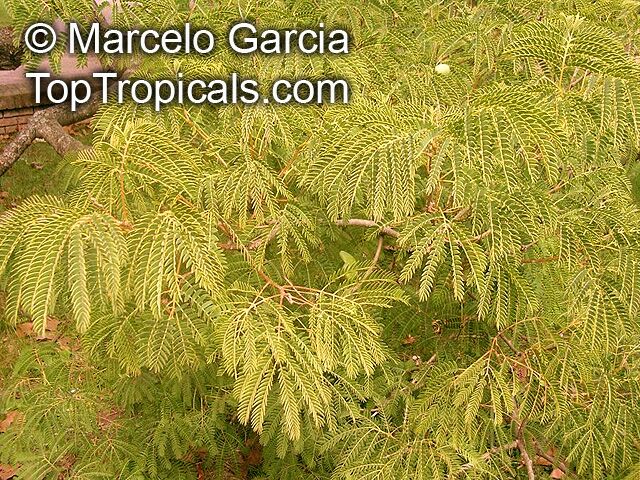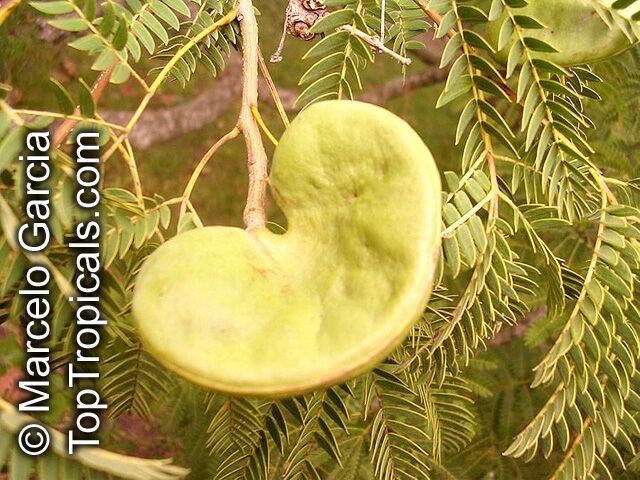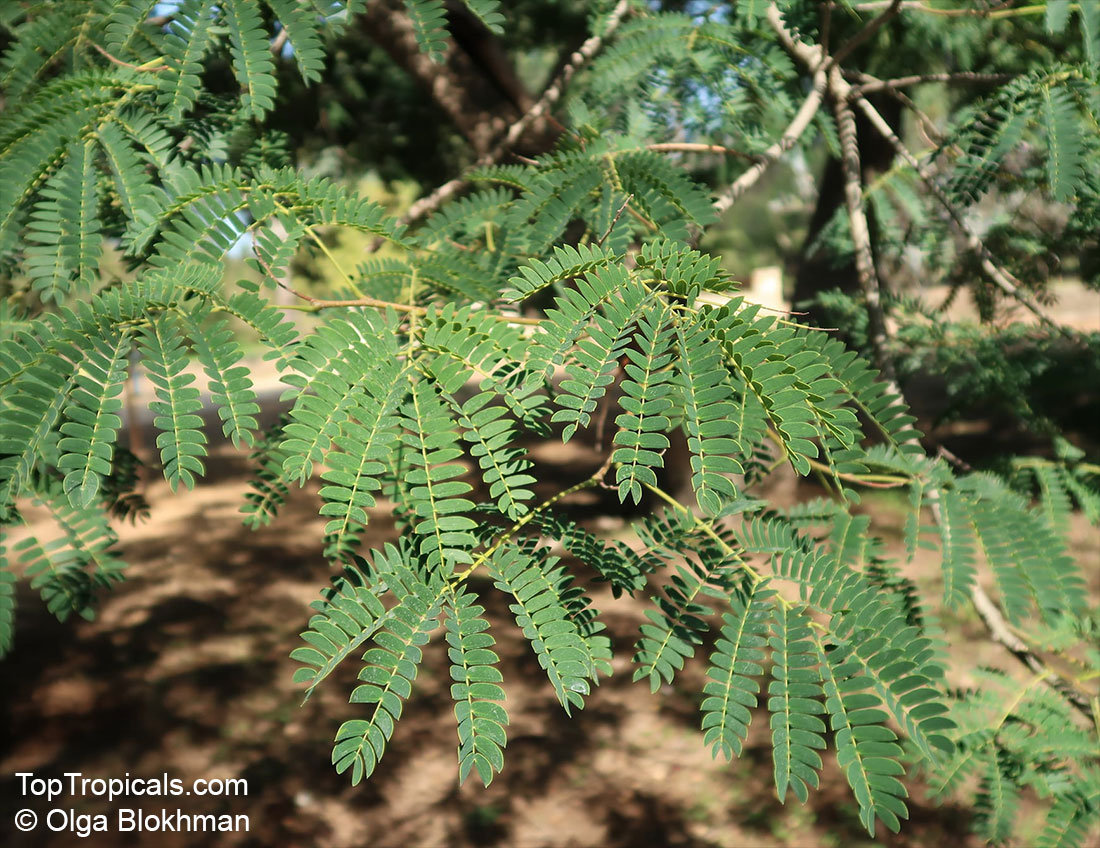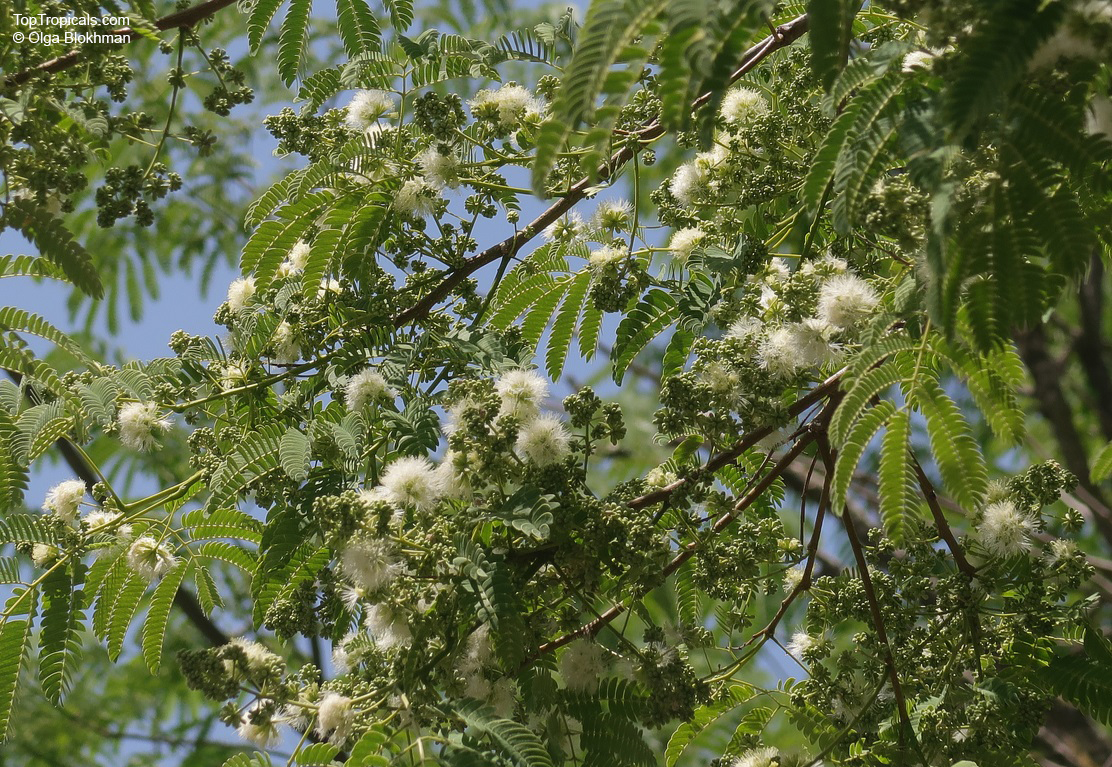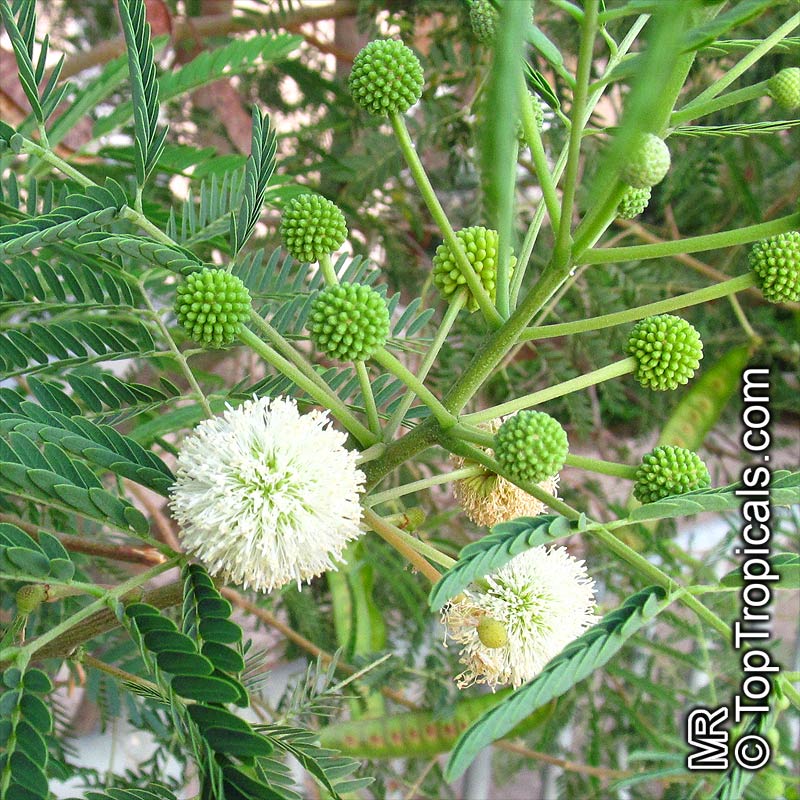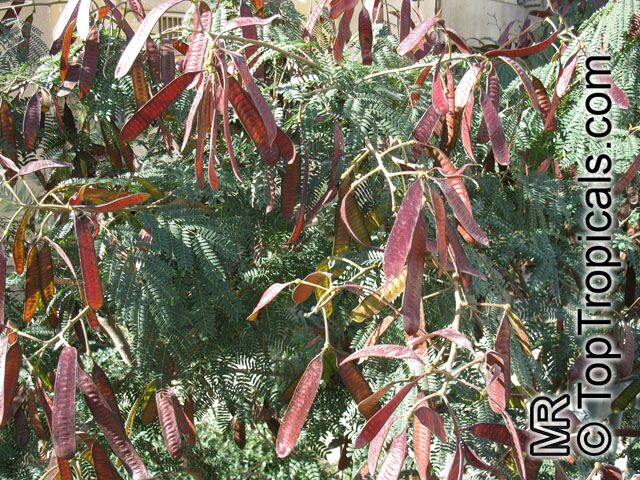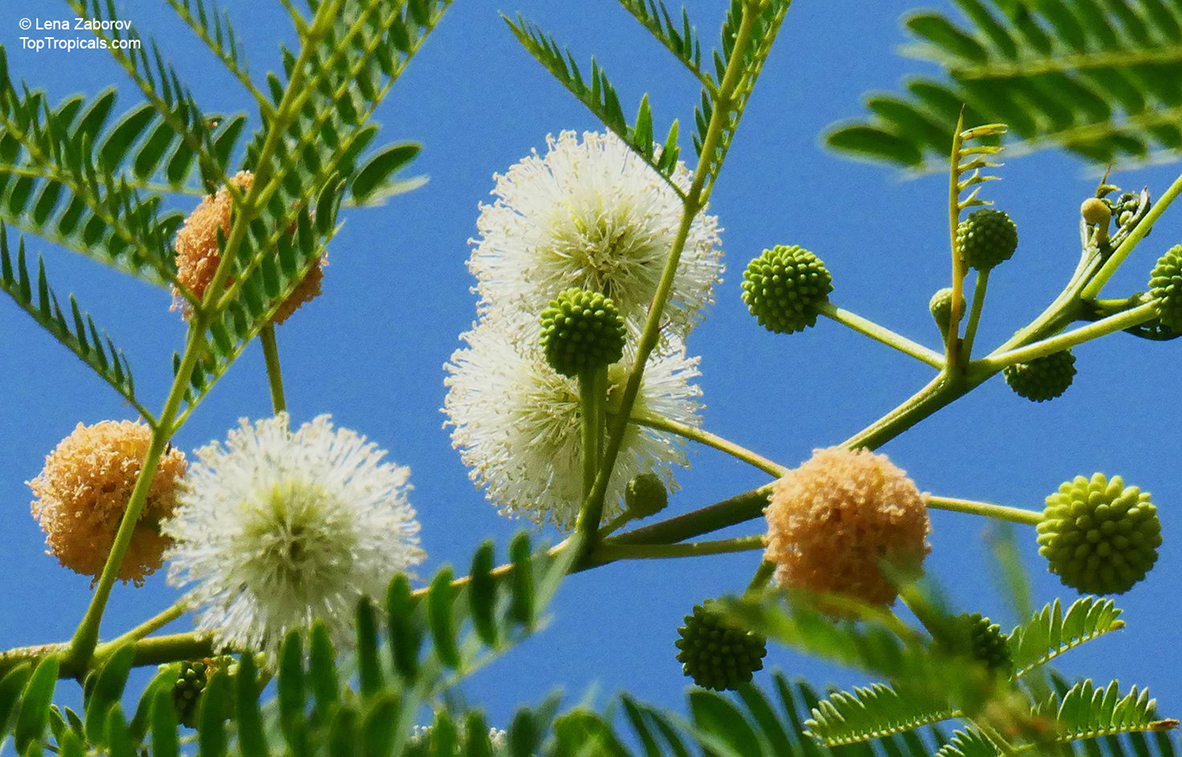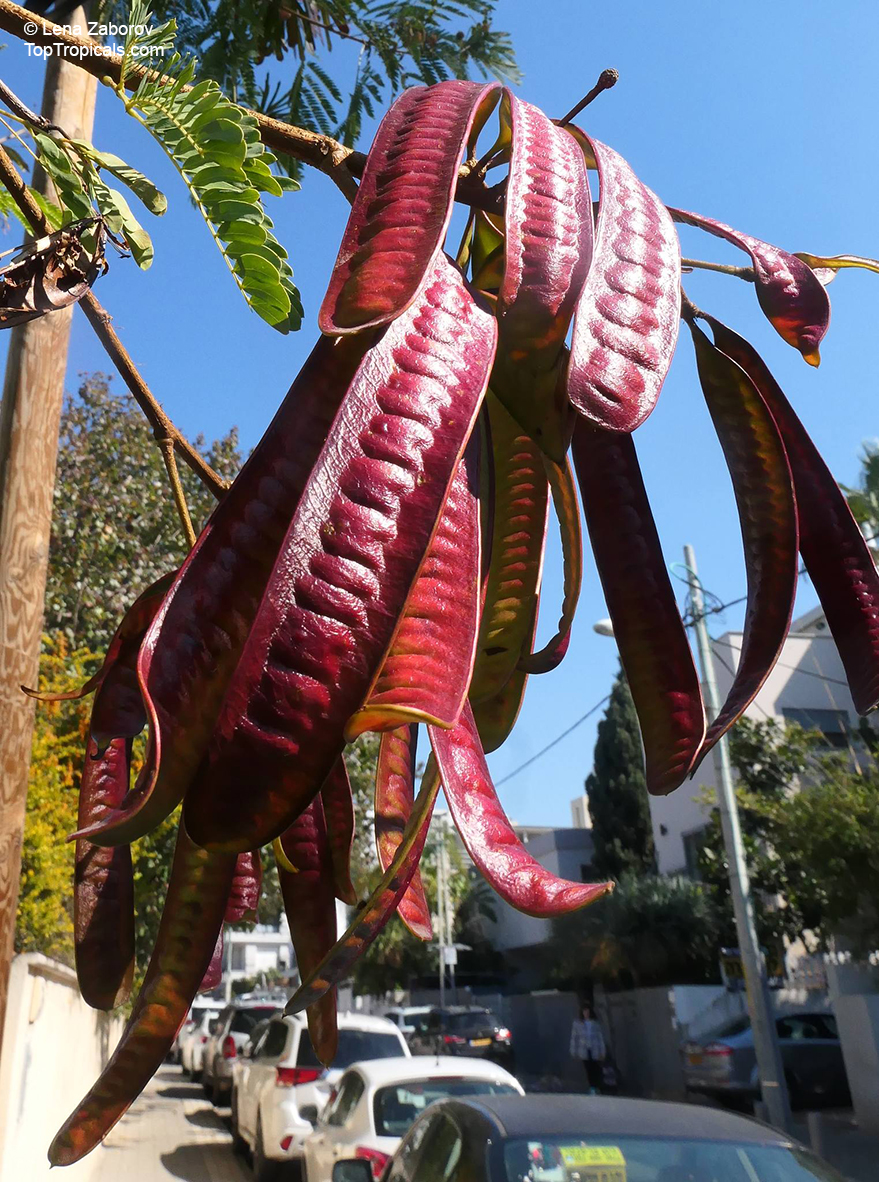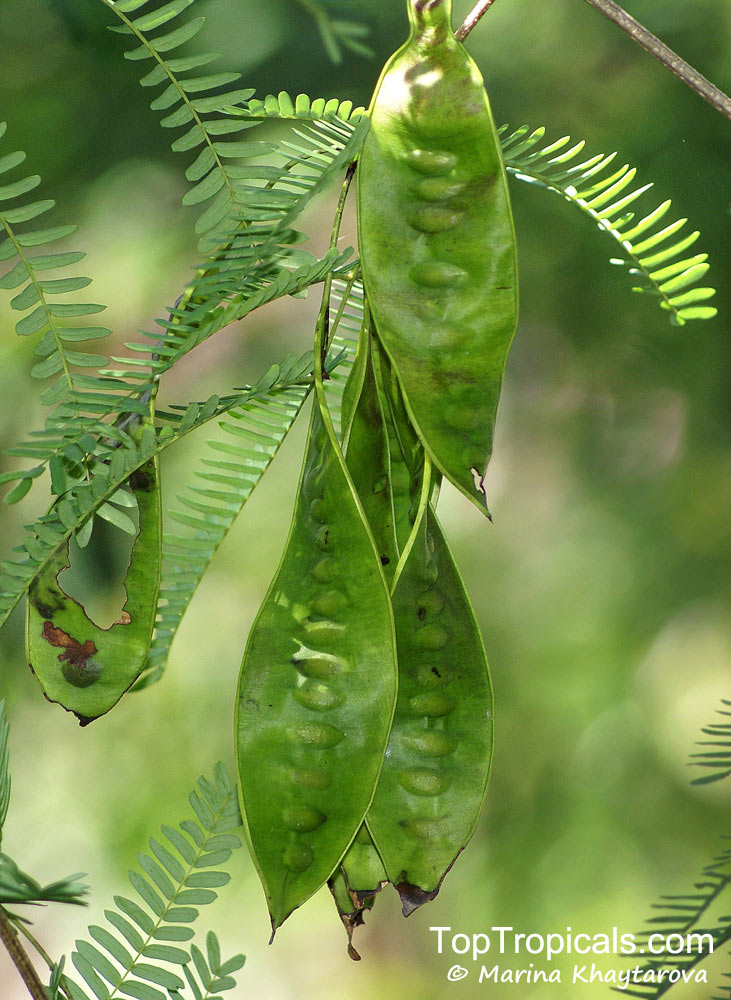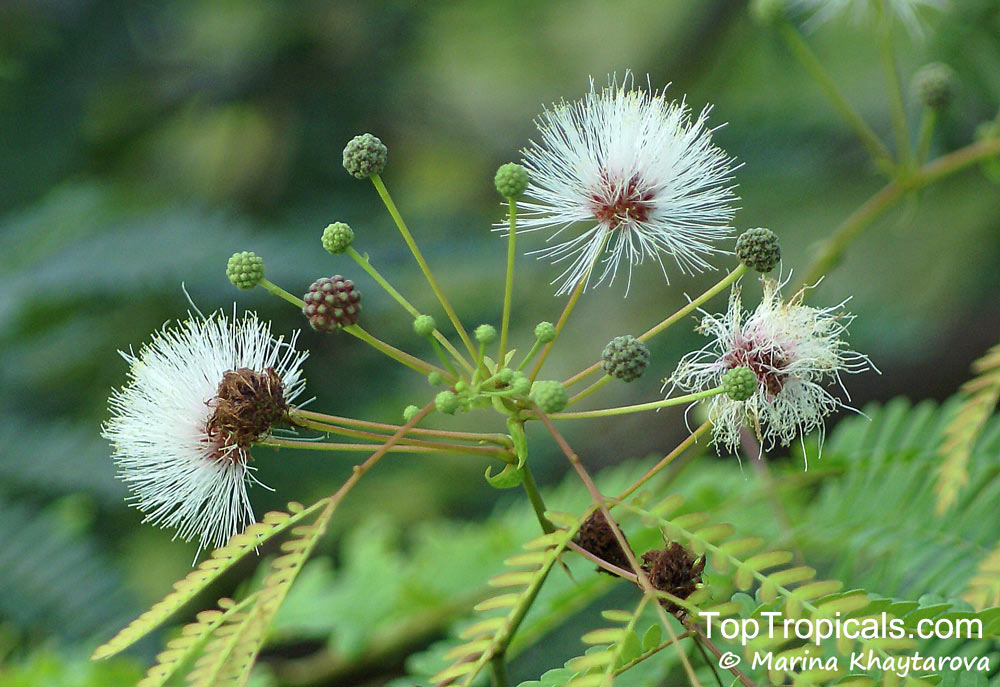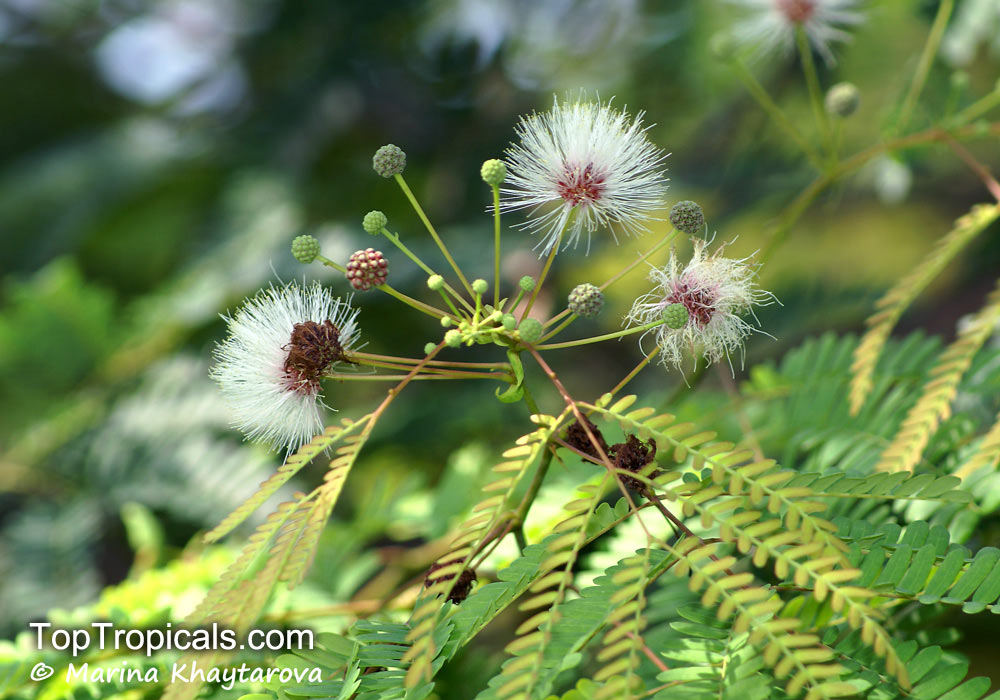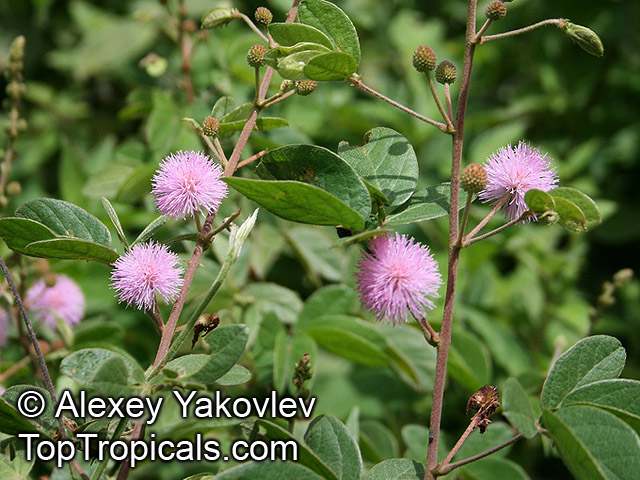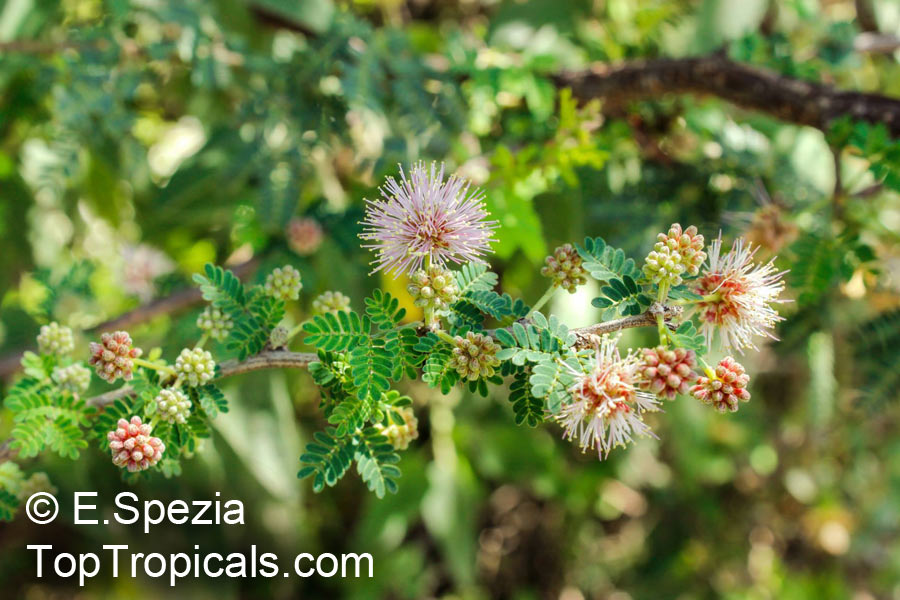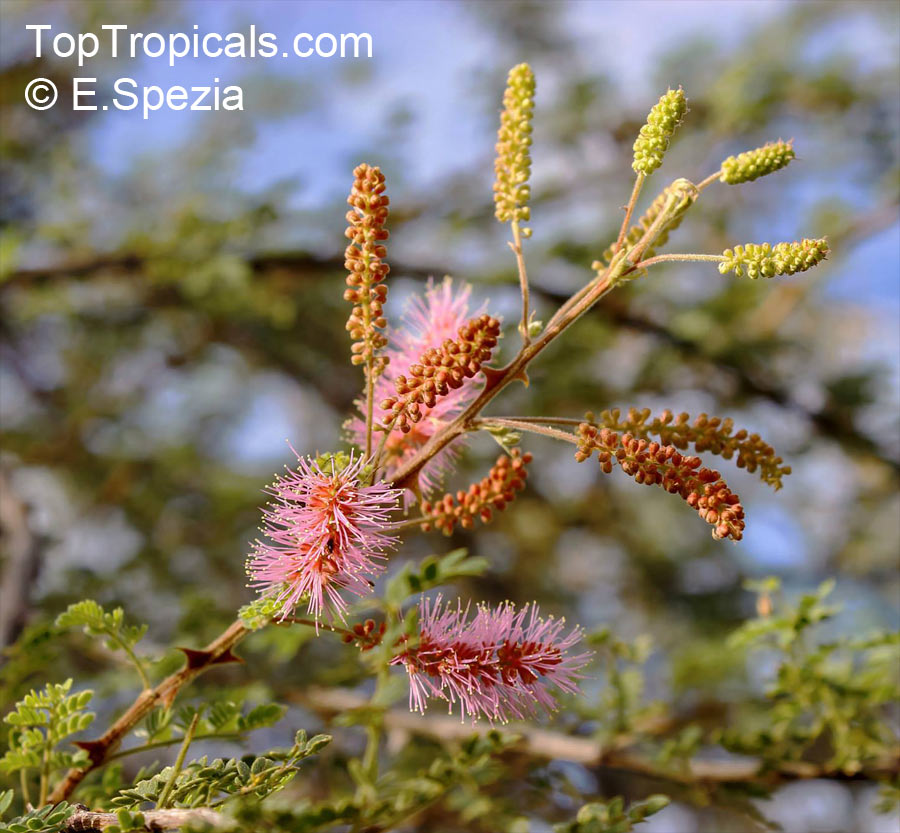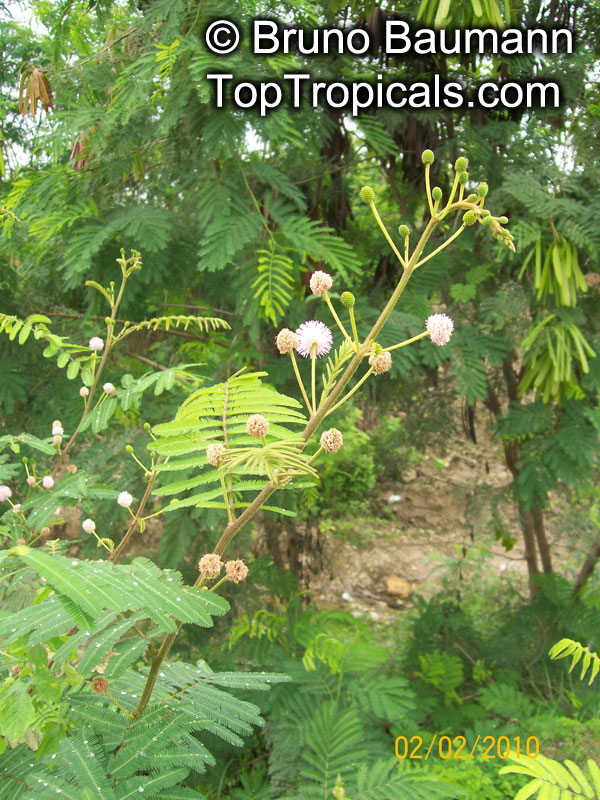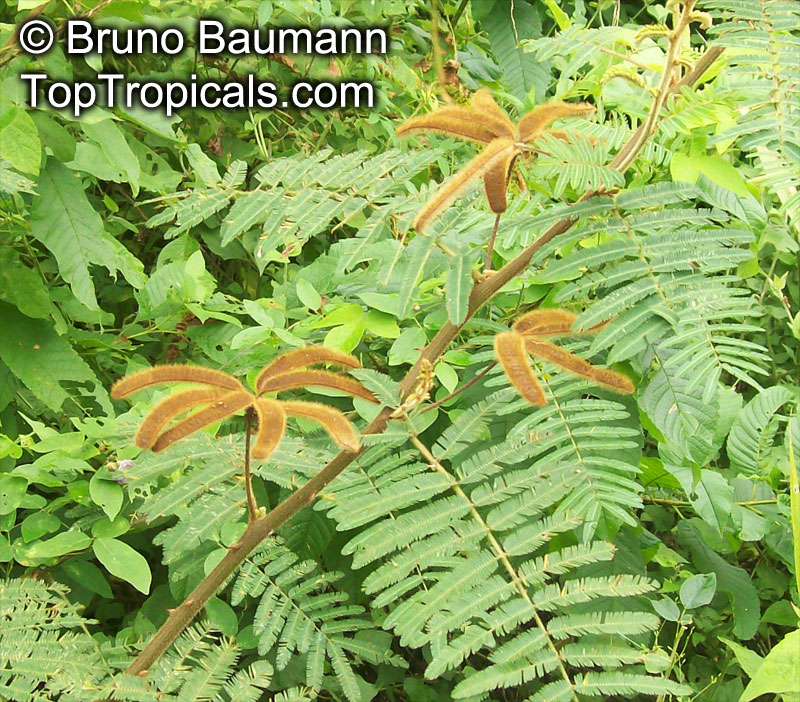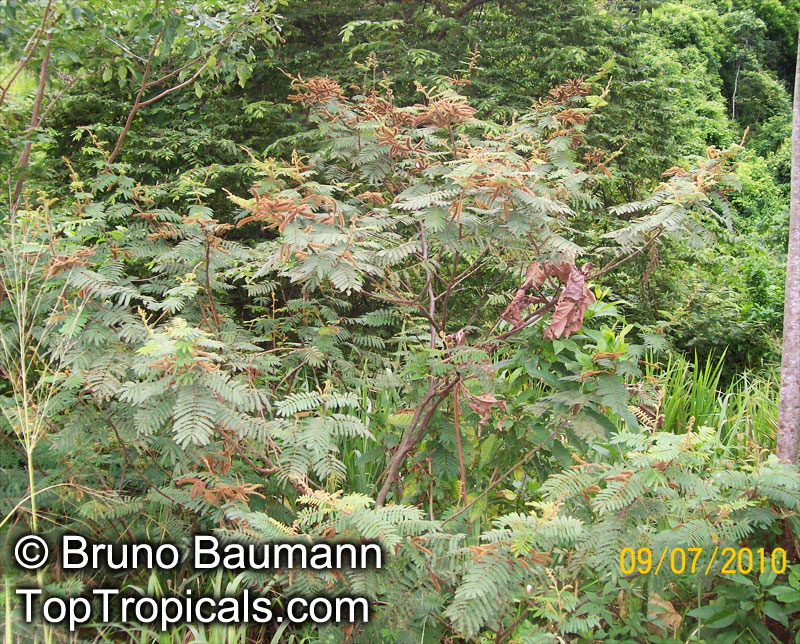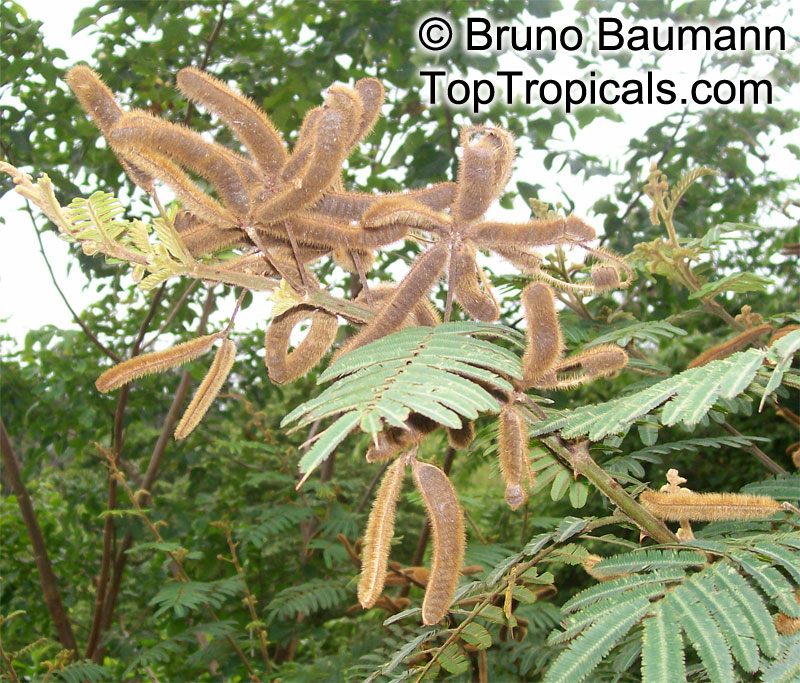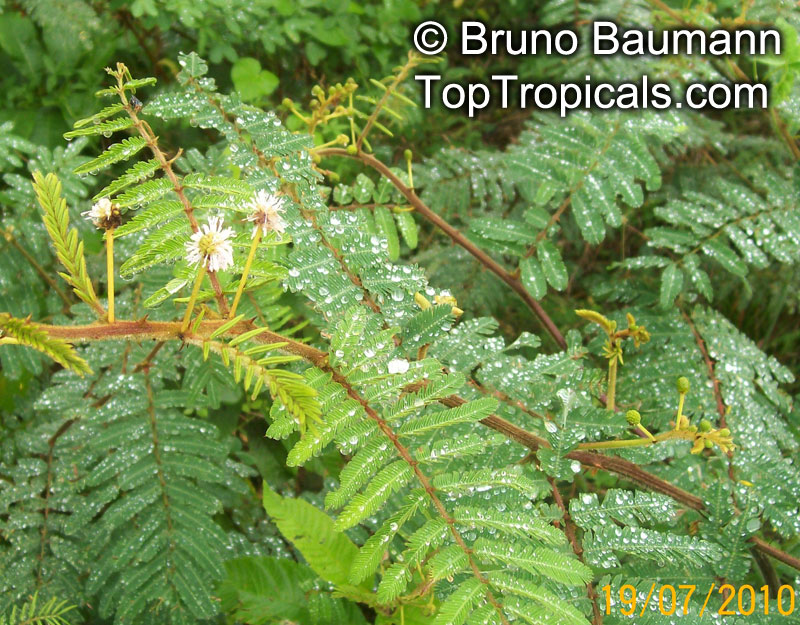Mimosa - Plant Encyclopedia Results
Top Tropicals Plant Encyclopedia
| Number of plants found: 20 | Next | 
|
Go to page: | 1 | 2 |
Botanical names: Acacia cavenia, Mimosa caven
Common names: Espino Cavan, Roman Cassie
Family: Fabaceae
Subfamily: Mimosoideae
Origin: Chile and Argentina





Botanical names: Albizia lebbeck, Mimosa lebbeck
Common names: Womans tongue, Siris-tree, Rain tree, East Indian walnut, Kokko, Soros-tree, Raom tree
Family: Fabaceae
Subfamily: Mimosoideae
Origin: India, Burma and the Andaman Island
Hardiness: 30°F







Albizia lebbeck, Mimosa lebbeck is a fast-growing tree, that is susceptible to wind damage. A moderate to large, deciduous tree can grow up to 100 feet high in rain forests. The tree develops a straight trunk when it is grown in dense forests, but is spreading and low branching in the open. Unless trimmed frequently, the trees will annually produce an abundance of seed from papery pods about 8" long and 1" wide (author). Common names such as "woman's tongue" and "rattle pod" derive from the noise of pods shaking in the wind. The foliage is pale green when young and gray-green at maturity. Flowers are cream colored, hemispheric pom-poms. Seeds germinate well without scarification.
The tree is used as a folk remedy for many ailments. Another common use is as an avenue tree, and sometimes it is used to shade coffee and tea. Saponins and tannins in the bark can be used for making soap and in tanning, respectively. Bee keepers like the species for the light-colored honey its nectar provides, and the tree hosts the lac insect.
Botanical names: Dichrostachys cinerea, Cailliea glomerata, Dichrostachys glomerata, Dichrostachys nutans, Mimosa cinerea
Common names: West African Sickle Bush, Marabou Thorn, Aroma, Kalahari Christmas tree, Chinese lantern tree, Marabou-thorn, Princess Earrings
Family: Fabaceae
Subfamily: Mimosoideae
Origin: Africa to India, Southern Thailand and Malesia, Northern Territories of Australia










Interesting powderpuff-like pink flowers make this plant unforgettable. Shrub up to 9ft high with grey bark and solitary thorns often bearing one or two leaves. Leaves bipinnate and finely pubescent, 1" to 3" long. Pendulous flower heads that are pink in the upper part and yellow in the lower part. Dark-brown pods, borne in clusters, twisted, each 1" to 3" long and 1" broad. Good plant for bonsai.
Recommended Fertilizer: SUNSHINE Megaflor - Bloom Nutrition Booster
Ordering seeds info
RECOMMENDED SUPPLIES:
Seed Germination Mix #3, professional grade
SUNSHINE-Epi - Seeds and cuttings booster
SUNSHINE Bombino - Young Plant Booster
Botanical names: Enterolobium contortisiliquum, Mimosa contortisiliqua
Common names: Earpod Tree, Orelha-de-macaco
Family: Fabaceae
Subfamily: Mimosoideae
Origin: South America





Enterolobium contortisiliquum, also known as Earpod Tree, is a deciduous plant native to South America. It is a big tree, growing taller than 20 ft with a broad crown, and can be found in USDA zones 9-11. It is a comparatively low maintenance tree, preferring full sun and an occasional watering. In the right conditions, it can be grown without irrigation.
The tree produces off-white to white flowers in the spring and early summer, which are followed by large and distinctive seedpods. These pods can be up to 6 in long and look like elephant ears. The leaves are bipinnate and can reach lengths of up to 12 in.
The Enterolobium contortisiliquum is a spectacular and unique addition to any garden or landscape. Its fruit and foliage provide texture to the landscape and its large size, beautiful flowers and ornamental seedpods guarantee a head-turning display.
Planting Enterolobium contortisiliquum is easy and, once established, requires minimal care. Plant it in well-draining soil and, if you live in a dry region, it can be beneficial to form a basin around the base of the trunk which will capture run-off water. In especially cold regions, potting up this tree can help it survive a harsher winter. When you do, opt for a large pot and use a mixture of potting soil, mulch and compost for a rich, well-draining mix. You should also use rainwater in the pot, as this will be better for your tree than tap water.
Overall, the Enterolobium contortisiliquum is an attractive and low-maintenance addition to any outdoor space. With its impressive size and ornamental look, it can add depth and character to any garden.
Botanical names: Leucaena leucocephala, Leucaena glauca, Mimosa leucocephala, Acacia leucocephala
Common names: Wild Tamarind, Lead Tree
Family: Fabaceae
Subfamily: Mimosoideae
Origin: West Indies, Bahamas and Cuba, Trinidad and Tobago, from Southern Mexico to Northern South America








Naturalized northward to southern Texas, California and southern Florida, and southward to Brazil and Chile: also naturalized in Hawaii and the Old World tropics. Leucaena leucocephala is spreading naturally and has been reported as a weed in more then 20 countries across all continents except Europe and Antarctica. It is a weed of open, often coastal or riverine habitats, semi-natural, and other disturbed or ruderal sites and occasionally in agricultural land. Arborescent deciduous small tree or shrub, to 67Ft tall, fast-growing; trunk 4" to 5" in diam. Forming dense stands; where crowded, slender trunks are formed with short bushy tuft at crown, spreading if singly grown; leaves evergreen, alternate, bipinnate with 3-10 pairs of pinnae; flowers numerous, axillary on long stalks, white, in dense global heads 1" across. Fruit pod with raised border, flat, thin, becoming dark brown and hard. It is used as a shade plant in coffee, rubber, cacao and cinchona plantations, for reforestation, windbreaks and firebreaks. Necklaces are made with the seeds. Leadtree is valued as an excellent protein source for cattle fodder, consumed browsed or harvested, mature or immature, green or dry. The nutritive value is equal to or superior to alfalfa. Leadtree has gained a favorable reputation in land reclamation, erosion control, water conservation, reforestation and soil improvement programs, and is a good cover and green manure crop. The leaves, used as a mulch around other crops, are said to significantly increase their yields. Indigenous people in Mexico and Central America, use it as a vegetable. Unripe seeds are consumed with gusto and added to salsa. Green seeds are also consumed raw in Thailand and Indonesia. It tolerates a wide range of rainfall from 500 - 3500 mm and withstands strongly seasonal (6-8 month dry season) climates. However, it is not frost hardy and grows poorly, setting less seed in cooler tropical highland sites. The species also grows poorly on the acid soils with high Aluminium saturation that prevail in many humid tropical areas. In broad terms, it thus adapts well to a wide range of tropical and subtropical environments, especially seasonally dry tropical areas. Trees, propagated by seed or cuttings coppice well. Some seedlings less than one-year old will produce viable seed. Seeds remain viable from several months to several years. The hard waxy seedcoat makes scarification necessary before planting.The easiest and most common method is to scald seed in boiling or near boiling water. Boiling water is poured directly over the seed and allowed to cool to room temperature (preferably overnight), followed by sowing. Alternatively, small numbers of seed may be scarified by nicking which involves the use of a knife or secateur to clip off a small portion of the seed coat at the end opposite the pod attachment scar (hilum). The resultant minor damage to the underlying cotyledons is inconsequential to the germinating seedlings. For forage, seed should be sown 2" to 5" deep, planting at onset of wet season. Leadtree responds favorably to fertilizer and lime. Irrigation and cultivation may be necessary. The crop soon produces a dense stand.
Botanical names: Lysiloma latisiliquum, Acacia bahamensis, Acacia formosa, Acacia latisiliqua, Leucaena latisiliqua, Lysiloma bahamensis, Lysiloma latisiliqua, Mimosa latisiliqua
Common names: Bahamas Lysiloma, Candelon, False Tamarind, Wild Tamarind
Family: Fabaceae
Subfamily: Mimosoideae
Origin: Central America








This tree is a popular nesting site for several native songbirds. Lysiloma latisiliquum, also known as Bahamas Lysiloma, is a native of Central America. It is a fast-growing, deciduous tree or shrub species which typically varies in size from a small tree, growing 10-20 ft tall, to a larger one of 20 ft or more. It is also salt tolerant and can be grown at seaside locations.
The tree develops off-white or white flowers in spring and summer. It has an open crown with drooping branches. Lysiloma latisiliquum prefers full sun to partial shade and requires moderate water, though it is fairly drought tolerant when established.
In order to enjoy the best results, it is important to grow Lysiloma latisiliquum in well-drained soils in USDA Zone 9-11. Plant maintenance includes removing competing vegetation and providing water during the dry season. Proper mulching also helps to keep the soil moist and provides nutrients. In colder climates, this plant should be grown in deep pots, repotted annually and moved indoors during winter.
This is a very attractive and popular species that will add a special flair to any landscape. In addition to providing extraordinary beauty, Lysiloma latisiliquum is also a great choice for attracting birds to your garden.
Botanical name: Mimosa albida
Common name: Mimosa
Family: Fabaceae
Subfamily: Mimosoideae
Origin: Tropical America







Botanical name: Mimosa borealis
Common names: Fragrant Mimosa, Pink Mimosa
Family: Fabaceae
Subfamily: Mimosoideae
Origin: Mexico









Fragrant Mimosa is a deciduous, small shrub, 3 by 3 feet, with somewhat zigzag, rigid branches with small, delicate pinnately compound leaves. The soft pink puffballs are a contrast to the sneaky, strongly recurved thorns up and down the branches.
An excellent plant for a xeriscape garden, Fragrant Mimosa can be planted in a garden with a desert theme, in rocky, sunny areas or as a backdrop. It will also tolerate partial shade. It makes a great background shrub.
Botanical name: Mimosa dysocarpa
Common names: Velvet Pod Mimosa, Gatuno, Velvetpod Catclaw
Family: Fabaceae
Subfamily: Mimosoideae
Origin: Mexico








Numerous short, widely divergent, irregular but densely prickly branches bear pubescent (downy) bipinnate leaves and extremely showy, fragrant, pinkish-purple cylindrical flower spikes.
This plant is extremely drought tolerant and can take reflected heat.
Botanical name: Mimosa pigra
Common name: Giant Sensitive Tree
Family: Fabaceae
Subfamily: Mimosoideae
Origin: Tropical America








Mimosa pigra is a leguminous shrub, which can reach up to 6m in height.
Mimosa pigra is closely related to Mimosa pudica. It can be distinguished from Mimosa pudica by its large size, large pods (6 to 8 cm long as opposed to 2.5 cm long) and leaves, which have 6 to 16 pairs of pinnae as opposed to 1 to 2 pairs on Mimosa pudica leaves
| Next |  |
Use link to repeat this search:
https://toptropicals.com/cgi-bin/garden_catalog/cat.cgi?find=Mimosa&search_op=and&keyword_op=and&language=e&number=10
&no_change_lang=1&user=tt&sale=1&first=0
